I had the chance to check in with Propel to get an update on their Product Value Management (PVM) strategy. I’m usually not a big fan of new acronyms, but they really are talking about something more than the current state of PLM. When I started researching PLM (two decades ago, yikes), I developed a…
- Improving Service Profitability with Remote Monitoring
- Begin the Remote Monitoring Journey to Service Performance
- Set Your Business Targets
- Access Equipment and Equipment Data
- Communicate with Equipment
- Transform Data to Increase Value
- Analyze Data to Create Service Intelligence
- Share Actionable Service Information
- Implementation and Adoption
- Selecting a Strategic Partner
- Next Steps
- Buyer's Guide Checklist
- Acknowledgments
Remote Machine Monitoring Drives Operational Improvements
IoT Machine Monitoring Opportunities Monitoring machines using the IoT offers significant business value including increased quality, manufacturing throughput, and service performance. Of these opportunities, transforming service has become a proven way to improve equipment performance and profitability in the field and in the factory. Service transformation is a good target because service organizations have increased their maturity in the last decade and are now more sophisticated and data-driven. In addition, IoT platforms are now available to ensure companies get beyond a “proof of concept” to improve performance and profitability at scale. And as Dr. Yuri Hovanski, Associate Professor of Mechanical Engineering at Brigham Young University (BYU), explains, “Companies have been using predictive maintenance for decades. It’s not new, but the cost to deploy it 20 years ago was phenomenally expensive.” The Time for Service Transformation is Now The leaders now have the opportunity to expand on early efforts, apply lessons learned from initial projects, and drive repeatable value that they can grow over time. Those that have not started, on the other hand, likely face competitive threats from more mature organizations.Improving Service Profitability with Remote Monitoring
Service is a Proven Value Driver The most common way that companies gain tangible performance gains from IoT is through improved service. The IoT lets companies transform service to generate more – and more profitable – service revenue. They do this by moving from reactive to proactive to predictive service. Service is an excellent opportunity to leverage advanced technologies like AI, machine learning, and big data analytics. The most common first step is reducing the cost of service through remote monitoring and is within reach for most companies. In addition, companies can improve performance through new service delivery processes like remote service. Use this Guide to Achieve Results This guide shares the tangible, practical steps companies can take to improve service through IoT remote equipment monitoring, how IoT platforms help deliver value, and how they can increase benefits with increased maturity. Then, the buyer’s guide focuses on the essential needs companies must consider to ensure a successful initiative. The requirements are intended to help companies frame their search process and efficiently find the right solution. The checklists go beyond software functionality to cover factors important to implementation, adoption, partner choice, and more. These are the factors that drive long-term business success from an IoT initiative.Manufacturers can see double-digit increases in throughput from predictive maintenance Dr. Yuri Hovanski, Associate Professor, BYU
A machine failed in 2020 that cost $450k in downtime and repair to get it back up and running. We implemented a monitoring solution and got an alert allowing us to take the machine down in planned downtime and repair it for $20k to $30k. Todd Earis, EATON
Next Steps
 Recognize the Potential
Leveraging the IoT can help companies improve service for themselves and their customers by reducing cost and transitioning to proactive and predictive service. Remote monitoring allows companies to identify and resolve issues remotely, providing faster service and increased uptime for the customer while reducing the cost of truck rolls and putting service technicians on site. It can go beyond cost savings to create a new source of revenue from paid upgrades or remotely enhancing equipment capabilities or permissions by “unlocking” enhanced capabilities via a subscription.
Get Started
Now, more than ever, it’s critical to get started. Service transformation has gone beyond the early adopters and is now becoming necessary to compete. Companies have to avoid “paralysis through analysis” and make tangible progress. As Danny Jackson of Autoliv advises, “Done is better than perfect, start doing some things. We lost some time trying to do it perfectly, then made more progress by doing things and learning from them.”
Adopt a Pragmatic Approach
Companies have to get started, but they shouldn’t try to accomplish everything at once. Instead, it’s essential to adopt an incremental approach. Companies can organize their service and machine monitoring efforts in small, manageable, incremental “sprints” that will result in broader, transformational value. Each effort should build on the prior one. Companies should create a framework as they solve the first problem, focusing on operationalizing their capabilities and building repeatable solutions.
Extend the Value
As companies become more experienced and data-centric, they can increase the maturity of their service applications and analytics. They can apply results in their own facilities to improve how they service smart products at customer locations. They can extend to other use cases such as customer self-service, remote maintenance, predicting yield, optimizing manufacturing processes, predicting scrap/rework, or reducing process variability. There is a lot of value available across the enterprise and the value chain in addition to improving service.
Recognize the Potential
Leveraging the IoT can help companies improve service for themselves and their customers by reducing cost and transitioning to proactive and predictive service. Remote monitoring allows companies to identify and resolve issues remotely, providing faster service and increased uptime for the customer while reducing the cost of truck rolls and putting service technicians on site. It can go beyond cost savings to create a new source of revenue from paid upgrades or remotely enhancing equipment capabilities or permissions by “unlocking” enhanced capabilities via a subscription.
Get Started
Now, more than ever, it’s critical to get started. Service transformation has gone beyond the early adopters and is now becoming necessary to compete. Companies have to avoid “paralysis through analysis” and make tangible progress. As Danny Jackson of Autoliv advises, “Done is better than perfect, start doing some things. We lost some time trying to do it perfectly, then made more progress by doing things and learning from them.”
Adopt a Pragmatic Approach
Companies have to get started, but they shouldn’t try to accomplish everything at once. Instead, it’s essential to adopt an incremental approach. Companies can organize their service and machine monitoring efforts in small, manageable, incremental “sprints” that will result in broader, transformational value. Each effort should build on the prior one. Companies should create a framework as they solve the first problem, focusing on operationalizing their capabilities and building repeatable solutions.
Extend the Value
As companies become more experienced and data-centric, they can increase the maturity of their service applications and analytics. They can apply results in their own facilities to improve how they service smart products at customer locations. They can extend to other use cases such as customer self-service, remote maintenance, predicting yield, optimizing manufacturing processes, predicting scrap/rework, or reducing process variability. There is a lot of value available across the enterprise and the value chain in addition to improving service.
Buyer’s Guide Checklist
Set Your Criteria and Get Started Remote equipment monitoring is a proven way to improve service. It’s also a valuable first step in the IoT journey and digital transformation. Companies embarking on a remote monitoring initiative to improve service should look for the capabilities outlined in this guide to help ensure they get the value they seek. In addition, they can use the following checklist as high-level criteria to compare offerings. Machine Monitoring Solution Checklist:- Develop a strategy to improve service performance
- Start small and expand value quickly
- Identify a problem that would be valuable to solve and will make a meaningful business impact
- Get the right capabilities to monitor equipment, analyze data, put data in context, and create actionable service intelligence
- Look for predefined connectivity, dashboards, analysis, and applications and don’t start from scratch
- Avoid the cost, repeatability, integration, and scalability pitfalls of “do it yourself” initiatives
- Adopt a platform approach to remote equipment monitoring
- Get the right business and technical help to drive successful adoption
- Create a foundation for future growth
- Look for a partner with IoT and business expertise and a comprehensive ecosystem
- Get started with remote monitoring to reduce service cost, grow service revenue, and develop stronger customer relationships
- Expand to other use cases to drive additional value
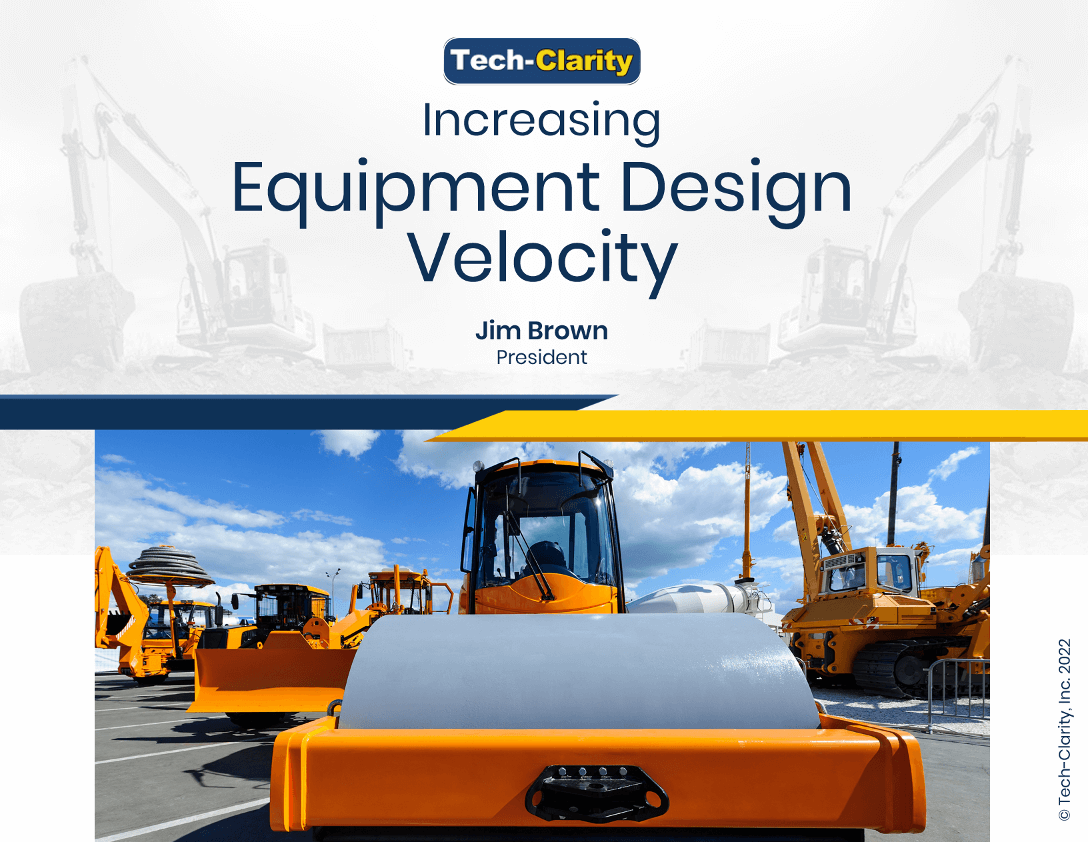 How can manufacturers accelerate equipment quotes, design, and delivery without sacrificing performance and quality? What four disciplines do they need to digitally transform their design processes to move faster and get designs right the first time despite increasing complexity?
Please enjoy the summary* below. For the full research, please visit our sponsor Siemens (registration required).
For related research, register for the upcoming live webinar: Accelerate equipment design using product design software.
How can manufacturers accelerate equipment quotes, design, and delivery without sacrificing performance and quality? What four disciplines do they need to digitally transform their design processes to move faster and get designs right the first time despite increasing complexity?
Please enjoy the summary* below. For the full research, please visit our sponsor Siemens (registration required).
For related research, register for the upcoming live webinar: Accelerate equipment design using product design software.
Table of Contents
- Innovation Introduces Complexity
- Embrace Complexity without Compromises
- Adopt a Comprehensive Digital Twin
- Integrate and Streamline Design
- Enable Cross-Discipline Collaboration
- Operationalize Program and Process Management
- Move Faster with a Comprehensive Digital Twin and Digital Continuity
- Acknowledgments
Rapidly Developing Complex Equipment
Accelerate Equipment Design to Drive Profits Speed is the key to top-line business performance. Equipment manufacturers must rapidly quote, design, and deliver machines to satisfy customers and drive revenue. But speed can’t come at the expense of performance, quality, and cost. Sacrificing product fundamentals leads to poor bottom-line profitability regardless of top-line growth. In addition, trading off quality, cost, and performance to meet due dates damages customer relationships and brand reputation. It’s time for equipment manufacturers to digitally transform equipment design and development so they can accelerate equipment design and get designs right the first time.Embrace Complexity without Compromises
Adopt a Better Design Process Despite the challenges, complexity isn’t an inherently bad thing. Manufacturers can embrace complexity to further technology advances like autonomous operations and connected work environments that allow them to bring new capabilities to market. In addition, they can differentiate by increasing configurability to better allow customers to tailor equipment more exactly to their needs. Mastering complexity lets manufacturers help their customers dramatically improve efficiency and productivity.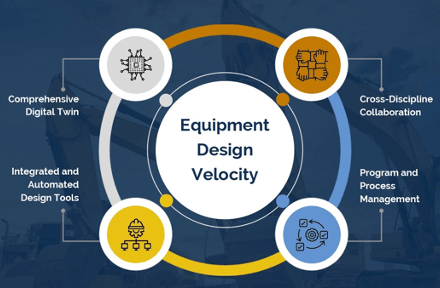 Digitally Transform
To compete in this complex environment, however, equipment manufacturers must digitally transform their product design and development processes to be as efficient, agile, and adaptable as possible. They have to be able to design more quickly without compromising quality, reliability, or performance. Accelerating design requires a better way of doing things, a collaborative, systems-oriented product development process based on digital data and process continuity. This process should allow them to iterate and innovate without fear, with the comfort that their design and engineering processes are under control.
Improve Four Disciplines to Drive Speed with Quality
Mastering the design of complex products is an opportunity to rise above the crowd. It’s time to digitally transform equipment design and development to raise the bar on the competition through rapid, accurate product design. To support this, we’ve identified four key disciplines to drive speed while accommodating complexity:
Digitally Transform
To compete in this complex environment, however, equipment manufacturers must digitally transform their product design and development processes to be as efficient, agile, and adaptable as possible. They have to be able to design more quickly without compromising quality, reliability, or performance. Accelerating design requires a better way of doing things, a collaborative, systems-oriented product development process based on digital data and process continuity. This process should allow them to iterate and innovate without fear, with the comfort that their design and engineering processes are under control.
Improve Four Disciplines to Drive Speed with Quality
Mastering the design of complex products is an opportunity to rise above the crowd. It’s time to digitally transform equipment design and development to raise the bar on the competition through rapid, accurate product design. To support this, we’ve identified four key disciplines to drive speed while accommodating complexity:
- Comprehensive Digital Twin
- Integrated and Automated Design Tools
- Cross-Discipline Collaboration
- Program and Process Management
Move Faster with a Comprehensive Digital Twin and Digital Continuity
Improve Processes Complex equipment manufacturers must reduce the time it takes to quote and deliver configured equipment to meet customer needs. Today’s markets are competitive and time is the key to winning business. However, companies can’t afford to increase design speed at the expense of performance, quality, or cost. Instead, manufacturers have to accelerate equipment design while getting things right the first time. Embrace Complexity Companies shouldn’t trade off complexity for speed, either. Equipment manufacturers have an opportunity to raise the bar on their competitors by not only managing the current complexity of mechatronic equipment but taking it to the next level. With process improvement, manufacturers can innovate with the confidence to incorporate new features and technologies including more electrified, connected equipment. Improve Enabling Technology Manufacturers can accelerate design without making compromises by adopting the following four key disciplines:- Comprehensive Digital Twin
- Integrated and Automated Design Tools
- Cross-Discipline Collaboration
- Program and Process Management
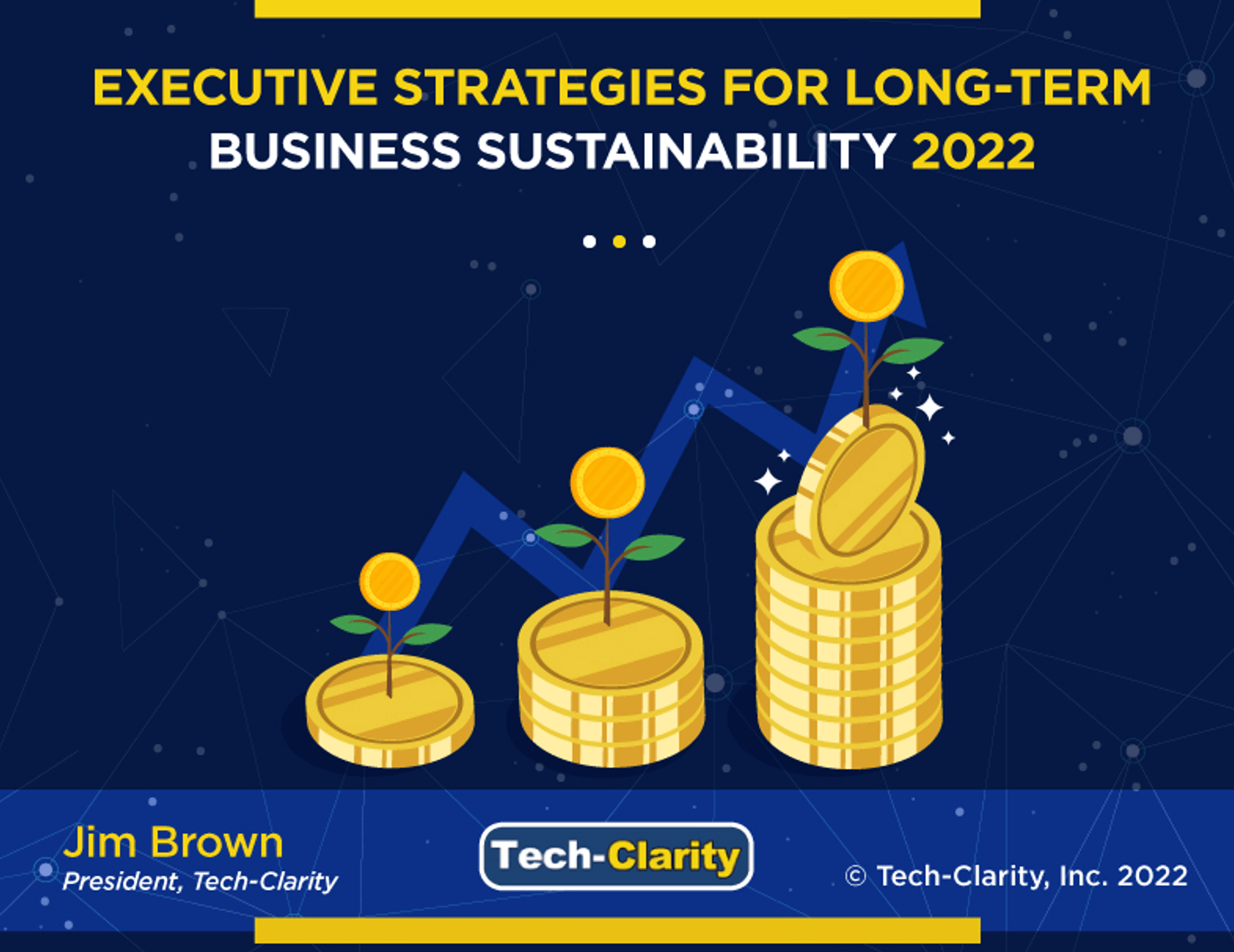 What strategies are companies adopting to ensure long-term business success and profitability as they experience constant business disruptions like COVID, supply chain instability, and now armed conflict in Ukraine? What impacts do these events, coupled with increased environmental, social, and governance (ESG) pressure, have on their business? How are they transforming to overcome growing risk? Read our 4th annual survey for insights.
Please enjoy the summary* below. For the full research, please visit our sponsor Dassault Systèmes (registration required).
For related research, please read our prior survey results: Business Sustainability and Transformation Strategies 2021, Business Sustainability and Survival 2020, and Executive Strategies for Long-Term Business Success 2019.
What strategies are companies adopting to ensure long-term business success and profitability as they experience constant business disruptions like COVID, supply chain instability, and now armed conflict in Ukraine? What impacts do these events, coupled with increased environmental, social, and governance (ESG) pressure, have on their business? How are they transforming to overcome growing risk? Read our 4th annual survey for insights.
Please enjoy the summary* below. For the full research, please visit our sponsor Dassault Systèmes (registration required).
For related research, please read our prior survey results: Business Sustainability and Transformation Strategies 2021, Business Sustainability and Survival 2020, and Executive Strategies for Long-Term Business Success 2019.
Table of Contents
- Business Risks and Disruption are Expanding
- European Conflict Adds to Existing Challenges*
- Fundamentals and Strategy Drivers Largely Unchanged*
- Focus on Long-Term Business Sustainability
- Increased Attention to ESG*
- Drivers of Increased ESG Focus*
- Companies Report Ambitious ESG Plans
- Companies Report Putting ESG Plans into Action*
- Adopting Technologies to Support the Pillars*
- Conclusions and Recommendations
- About the Research*
- Acknowledgments*
Risk and Disruption Persist, ESG Pressure Grows
Business Risk and Disruption Continue to Climb “Business is all about risk taking and managing uncertainties and turbulence,” said billionaire industrialist Gautam Adani. Managing disruption may never have been more important than over the last decade. Starting in 2019, our research series, Executive Strategies for Long-Term Business Success, reported significant growth in business risk and disruption. The survey series then tracked related business trends, as companies shifting focus to survive the COVID-19 pandemic in 2020. Then, in 2021, companies leveraged digital technologies to emerge more agile and resilient to disruption. This year finds business risk and disruption increasing again, highlighted by supply chain disruption, energy shortages, and labor shortfalls. In addition, the conflict in Ukraine is creating extensive global market impacts. Increasing Urgency on Sustainability Issues Beyond these disruptions, the 2022 survey finds increasing business pressure related to environmental, social, and governance (ESG) concerns. Environmental compliance and social responsibility have always been pillars of long-term business sustainability. Now, they have become more urgent as climate change advances, financial markets pay more attention, and governments adopt specific dates to achieve goals such as net zero carbon. Our survey of 183 companies now finds that ESG is a more urgent part of a comprehensive business sustainability strategy that includes digital transformation, product/service innovation, developing/retaining the future, and capturing knowledge/IP. What are companies doing to ensure long-term business success in these turbulent times? How can they leverage the pillars of long-term business sustainability to succeed?Focus on Long-term Business Sustainability
Focus on the Pillars of Business Sustainability Our executive survey series tracks a collection of areas companies must address to survive and thrive despite persistent risk and disruption. These pillars have evolved with our research and include:- Digital Transformation / Adopting New Technology
- Product / Service Innovation and Agility
- Workforce Development
- Environmental and Social Sustainability
- Adopting New Business Models
Companies Report Ambitious ESG Plans
Companies Recognize Business Impact of ESG Initiatives Drilling down into sustainability plans, researchers investigated which goals companies believe will significantly impact their company’s long-term success. More than three-quarters of companies viewed all of the ESG initiatives investigated as either critical or important to their success. This perspective confirms that all of these initiatives; shifting to renewable energies, adopting circular economy principles, pursuing sustainable production, and reducing carbon, are business necessities. Fortunately, these initiatives are interrelated, and pursuing any of them may help reach the objectives of others. For example, renewable energies can help reduce carbon emissions. Going Beyond the Minimum ESG needs are essential to business success and becoming higher priorities due to customer and market demands. So how are companies reacting to requirements? In prior studies and experience, we’ve encountered many companies doing the least they could do, typically to avoid regulatory action. In this study, we asked respondents to share both the timing and the scope of their company’s plans to meet environmental and social responsibility requirements. The majority of responding companies focus on meeting all customer / government requirements for scope and timing. Conversely, very few companies only plan to meet either “some or very few” or only address requirements that are most actively enforced or expected to be enforced. In fact, about one-third of companies plan to exceed expectations. Of course, stating these as objectives is not as easy as attaining these goals, but it's a positive sign that companies are taking a more proactive stance on ESG.Conclusions and Recommendations
Take a Balanced Approach to Business Sustainability Companies will have to continue to deal with business risk and disruption. It is the status quo. Although companies are moving away from the crisis response to COVID, they are still dealing with supply chain, energy, workforce, and financial market issues that are getting worse due to factors like the conflict in Europe. Companies must focus on business fundamentals and be agile to adapt to changing circumstances so they can drive long-term business success. They need to take a balanced approach to address all of the pillars of business sustainability, including:- Digital Transformation / Adopting New Technology
- Product / Service Innovation and Agility
- Workforce Development
- Environmental and Social Sustainability
- Adopting New Business Models
 The most surprising finding in this year’s study is a significant rise in focus on ESG. Survey results show an increased recognition of ESG’s role in maintaining success and profitably over the long term. Customers and markets are now demanding social and environmental sustainability.
Although prior surveys showed an awareness of these needs, there was a significant disconnect between awareness and action. The most dramatic change in the data is that companies report that they are taking action. Respondents report that they are actively pursuing ESG goals, including:
The most surprising finding in this year’s study is a significant rise in focus on ESG. Survey results show an increased recognition of ESG’s role in maintaining success and profitably over the long term. Customers and markets are now demanding social and environmental sustainability.
Although prior surveys showed an awareness of these needs, there was a significant disconnect between awareness and action. The most dramatic change in the data is that companies report that they are taking action. Respondents report that they are actively pursuing ESG goals, including:
- Renewable energies
- Circular economy
- Sustainable production
- Decarbonization / reducing carbon
 What do industry experts and your manufacturing peers have to say about Industry 4.0 and smart manufacturing initiatives? Join this free live event on October 6th in Charlotte, North Carolina to learn and share your experience.
Our own Jim Brown will keynote the conference. He will share his research on how manufacturers can “bounce forward” from recent disruptions with smart manufacturing. Then you’ll hear from a host of knowledgeable speakers and have the opportunity to join in the roundtable discussion to learn from the presenters, panelists, and peers alike. And you can stay for the happy hour to continue the conversations or just enjoy the experience at The Barrel Room at Trip C Brewing Co.
What do industry experts and your manufacturing peers have to say about Industry 4.0 and smart manufacturing initiatives? Join this free live event on October 6th in Charlotte, North Carolina to learn and share your experience.
Our own Jim Brown will keynote the conference. He will share his research on how manufacturers can “bounce forward” from recent disruptions with smart manufacturing. Then you’ll hear from a host of knowledgeable speakers and have the opportunity to join in the roundtable discussion to learn from the presenters, panelists, and peers alike. And you can stay for the happy hour to continue the conversations or just enjoy the experience at The Barrel Room at Trip C Brewing Co.
 List of speakers:
List of speakers:
- Jim Brown (keynote) – President and Founder, Tech-Clarity
- Bouncing Forward with Smart Manufacturing Solutions
- Michael P Manzi - Practice Lead, Digital Manufacturing, Feyen Zylstra
- The Threat of Cyber Security
- John Keyes - Director, Smart Manufacturing Innovation, Feyen Zylstra
- Sustainability & The Smart Manufacturing Imperative
- Kausik Dasgupta - Vice President of Technology, FactoryEye
- Data Lakes - Why Should I Care? They are not a nice-to-have but a must-have for manufacturers
- Tim Stuart - Senior Industry Analyst Visual Decisions, Visual Decisions
- Linking Functional Improvement to Bottom-Line ROI
- Mick Holly - Strategic Advisor, Audere Partners
- How to Unleash Employee Potential
- Jane Biddle, Moderator, FactorEye
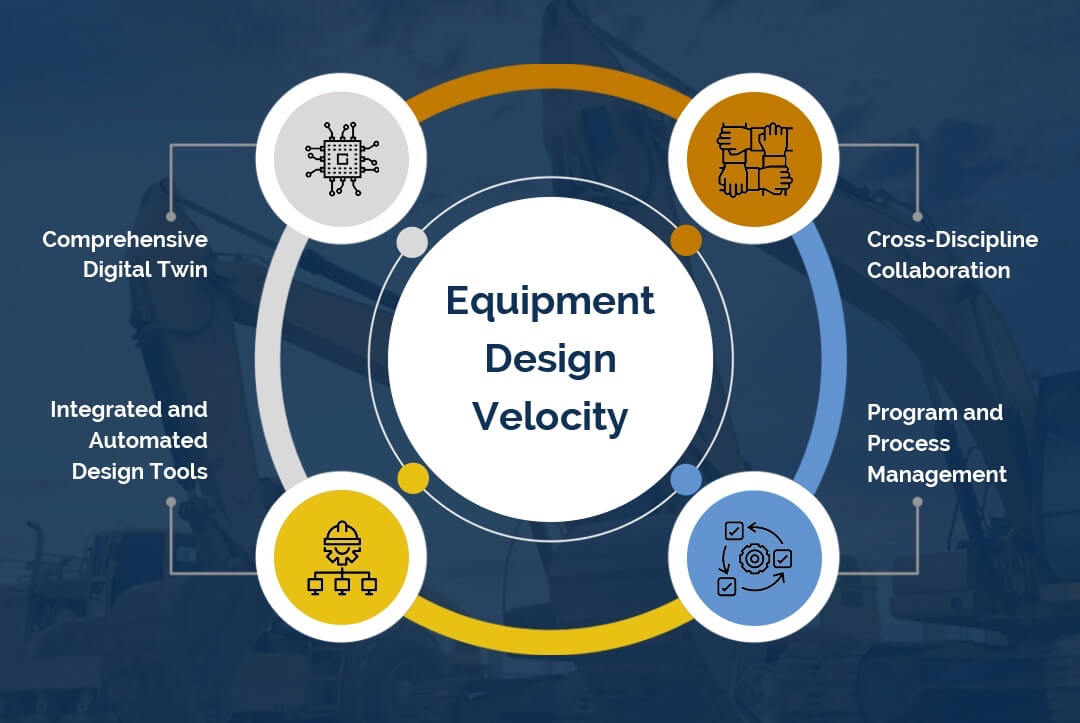 How can heavy equipment manufacturers accelerate how they quote, build, and deliver equipment to grow revenue without forfeiting profits by sacrificing quality and performance? This webinar shares four disciplines that equipment producers can adopt to implement a world-class design process based on a comprehensive digital twin and digital continuity.
Register for this live webinar sponsored by Siemens on September 28th to hear Jim Brown share the results of his recent research, Increasing Equipment Design Velocity.
For related research, watch the Improving Performance Engineering webinar to learn how companies can increase performance engineering maturity to develop more innovative, high-performance equipment with fewer prototypes and lower costs.
[post_title] => Four Disciplines to Accelerate Heavy Equipment Design
[post_excerpt] =>
[post_status] => publish
[comment_status] => open
[ping_status] => open
[post_password] =>
[post_name] => heavy-equipment-design-webinar
[to_ping] =>
[pinged] =>
[post_modified] => 2023-12-15 16:26:32
[post_modified_gmt] => 2023-12-15 21:26:32
[post_content_filtered] =>
[post_parent] => 0
[guid] => https://tech-clarity.com/?p=11835
[menu_order] => 0
[post_type] => post
[post_mime_type] =>
[comment_count] => 0
[filter] => raw
)
[6] => WP_Post Object
(
[ID] => 11810
[post_author] => 2572
[post_date] => 2022-09-13 09:00:50
[post_date_gmt] => 2022-09-13 13:00:50
[post_content] =>
How can heavy equipment manufacturers accelerate how they quote, build, and deliver equipment to grow revenue without forfeiting profits by sacrificing quality and performance? This webinar shares four disciplines that equipment producers can adopt to implement a world-class design process based on a comprehensive digital twin and digital continuity.
Register for this live webinar sponsored by Siemens on September 28th to hear Jim Brown share the results of his recent research, Increasing Equipment Design Velocity.
For related research, watch the Improving Performance Engineering webinar to learn how companies can increase performance engineering maturity to develop more innovative, high-performance equipment with fewer prototypes and lower costs.
[post_title] => Four Disciplines to Accelerate Heavy Equipment Design
[post_excerpt] =>
[post_status] => publish
[comment_status] => open
[ping_status] => open
[post_password] =>
[post_name] => heavy-equipment-design-webinar
[to_ping] =>
[pinged] =>
[post_modified] => 2023-12-15 16:26:32
[post_modified_gmt] => 2023-12-15 21:26:32
[post_content_filtered] =>
[post_parent] => 0
[guid] => https://tech-clarity.com/?p=11835
[menu_order] => 0
[post_type] => post
[post_mime_type] =>
[comment_count] => 0
[filter] => raw
)
[6] => WP_Post Object
(
[ID] => 11810
[post_author] => 2572
[post_date] => 2022-09-13 09:00:50
[post_date_gmt] => 2022-09-13 13:00:50
[post_content] =>  How do Top Performing companies get better results with their multi-disciplinary development projects?
Projects involving multiple engineering disciplines such as mechanical, electrical, and software can be incredibly complex. How much time do team members waste searching for information, investigating and fixing errors, dealing with integration issues, working around poor architecture design choices, and redoing work due to miscommunications? How much better could products be if more of that time went to innovation and improving designs? How do Top Performing companies deal with this?
How to Improve Multi-Disciplinary Project Performance with Model-Based Systems Engineering (MBSE), a research study based on a survey of 193 companies, examines the practices of those involved with multi-disciplinary development projects. The study looks at what Top Performing companies do to achieve better results than their peers and identifies how any company can improve efficiency, lower cost, and increase quality.
Please enjoy the summary* below. For the full research, please visit our sponsor IBM (registration required).
How do Top Performing companies get better results with their multi-disciplinary development projects?
Projects involving multiple engineering disciplines such as mechanical, electrical, and software can be incredibly complex. How much time do team members waste searching for information, investigating and fixing errors, dealing with integration issues, working around poor architecture design choices, and redoing work due to miscommunications? How much better could products be if more of that time went to innovation and improving designs? How do Top Performing companies deal with this?
How to Improve Multi-Disciplinary Project Performance with Model-Based Systems Engineering (MBSE), a research study based on a survey of 193 companies, examines the practices of those involved with multi-disciplinary development projects. The study looks at what Top Performing companies do to achieve better results than their peers and identifies how any company can improve efficiency, lower cost, and increase quality.
Please enjoy the summary* below. For the full research, please visit our sponsor IBM (registration required).
Table of Contents
- Executive Summary
- Importance of Systems Engineering Best Practices
- Business Impact of System Challenges
- Identifying Top Performers
- Top Performers' Strategies
- Model-Based Systems Engineering (MBSE)
- What to Look for in an MBSE Solution
- How Top Performers Use MBSE
- Preparing Staff to Support MBSE
- Drivers to Adopt MBSE
- MBSE Results
- Recommendations
- About the Research
- Acknowledgments
Executive Summary
Today's Modern Products Many of today’s products have evolved into complex systems of mechanical components, electronics, and software. Consequently, systems engineering best practices have become essential as demand for integrated systems has continued to increase. These practices have become instrumental to product development in many industries, especially aerospace and defense, automotive, industrial machinery, medical devices, consumer electronics, and others. The Cost of Suboptimal Processes While companies continue to release products, most struggle with increasing complexity, more requirements, late discovery of problems, and poor collaboration. Unfortunately, these challenges add significant cost and hurt profitability. While these costs may not be easy to quantify, do not underestimate their impact as product complexity grows. Those who do not look for better ways to manage these challenges risk falling behind their competition and suffering significant profitability hits. This research explores the plans Top Performers have for the next 12 months, revealing insights companies can use to improve their development processes. Top Performers plan to embrace digitalization further, invest in solutions that better integrate engineering disciplines, adopt systems engineering best practices, and transition from a document-based approach to a model-based one. A finding that stood out is that Model-Based Systems Engineering (MBSE) is becoming a crucial enabler. MBSE An overwhelming 97% of Top Performing companies have adopted MBSE or plan to adopt it. Companies that have already adopted MBSE report benefits such as a single source of truth, improved traceability, and a common visual reference. As a result, their teams are more productive and produce higher-quality products. While 99% of all companies that have deployed MBSE report benefits, Top Performers experience even more value due to how they adopt and use the solution. Further, many companies that have adopted MBSE report even more benefits than anticipated by their own estimations. This Research Report This research report reveals:- Why you should consider adopting MBSE
- How to get even more value from MBSE
- Benefits you can expect to realize with MBSE
 Business Impact of System Challenges
Business Impact of System Challenges
Business Impacts
While products still get released, ignoring the top challenges of system design comes at a high cost. The graph reveals the top business impacts of the challenges associated with designing multi-disciplinary systems.
Higher Cost
 Without suitable methods for managing system complexity, mistakes are hard to avoid. It’s also harder to catch errors early and identify all the impacts, especially considering interdependencies across components and subsystems. Finding problems late can result in rework, hours or even days of wasted effort, and scrap, increasing costs. Plus, late discovered problems take longer to correct, which means longer development times and delays, further increasing development costs. Then when you consider the impact across all system variants, costs grow exponentially.
The lack of good ways to plan and visualize complex systems can compromise optimal decisions around system architecture. This can lead to higher product costs and more brittle systems that make changes even more expensive and time-consuming.
Less Innovation and Revenue
Innovation sets your products apart, excites customers, and drives revenue opportunities. If your development teams cannot deliver on innovation, your company will miss out on future revenue streams and lose market share to more innovative competitors.
Innovation requires dedicated effort. However, engineers report they waste over half their time on system integration, which consumes their bandwidth to innovate.
Without suitable methods for managing system complexity, mistakes are hard to avoid. It’s also harder to catch errors early and identify all the impacts, especially considering interdependencies across components and subsystems. Finding problems late can result in rework, hours or even days of wasted effort, and scrap, increasing costs. Plus, late discovered problems take longer to correct, which means longer development times and delays, further increasing development costs. Then when you consider the impact across all system variants, costs grow exponentially.
The lack of good ways to plan and visualize complex systems can compromise optimal decisions around system architecture. This can lead to higher product costs and more brittle systems that make changes even more expensive and time-consuming.
Less Innovation and Revenue
Innovation sets your products apart, excites customers, and drives revenue opportunities. If your development teams cannot deliver on innovation, your company will miss out on future revenue streams and lose market share to more innovative competitors.
Innovation requires dedicated effort. However, engineers report they waste over half their time on system integration, which consumes their bandwidth to innovate.
Recommendations
Recommendations and Next Steps Developing multi-disciplinary systems is inherently complex. Suboptimal processes can result in higher costs, less innovation, lost revenue, and poor quality. However, companies can enjoy a competitive advantage by improving profitability with the right practices and technology. MBSE can be particularly useful. Based on industry experience and research for this report, Tech-Clarity offers the following recommendations to improve the development of multi-disciplinary systems:- Transition from a document-centric approach to a model-based one to enjoy the benefits of digitalization and greater automation of development processes.
- Invest in solutions that will integrate content across engineering disciplines to support better collaboration across the development team, throughout the lifecycle.
- Think about software development early in the lifecycle. Developing optimized complex products may require rethinking traditional hardware approaches, starting with a system-level approach that considers software from the start.
- Consider adopting MBSE as part of recommended systems engineering best practices.
- Leverage MBSE throughout the entire development lifecycle, not just as an upfront tool for initial definitions, but also use it for simulating and prototyping to verify and validate the system.
- Think through how to best support your staff to overcome cultural resistance so that they are more open to MBSE adoption.
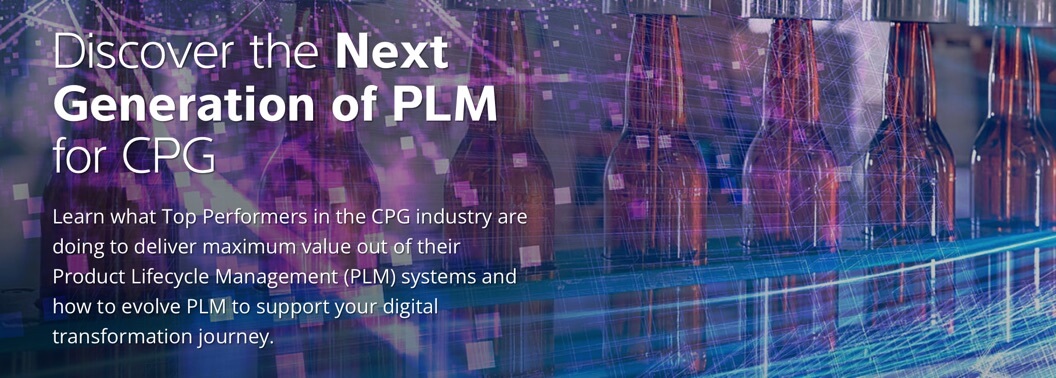 What does the future of PLM look like in the CPG industry? Watch this webcast to gain insights into the value of PLM, its importance to broader supply chain and digital thread processes, and its ability to help CPG companies innovate smarter and faster than ever before.
Jim shares the findings from his survey on the future of PLM in CPG and engages an industry expert panel including:
What does the future of PLM look like in the CPG industry? Watch this webcast to gain insights into the value of PLM, its importance to broader supply chain and digital thread processes, and its ability to help CPG companies innovate smarter and faster than ever before.
Jim shares the findings from his survey on the future of PLM in CPG and engages an industry expert panel including:
- Sachin Misra, Principal and Global Lead Life Sciences at Kalypso
- John Kelley, VP of Product Strategy at Oracle
- Jim Brown, President of Digital Innovation at Tech-Clarity
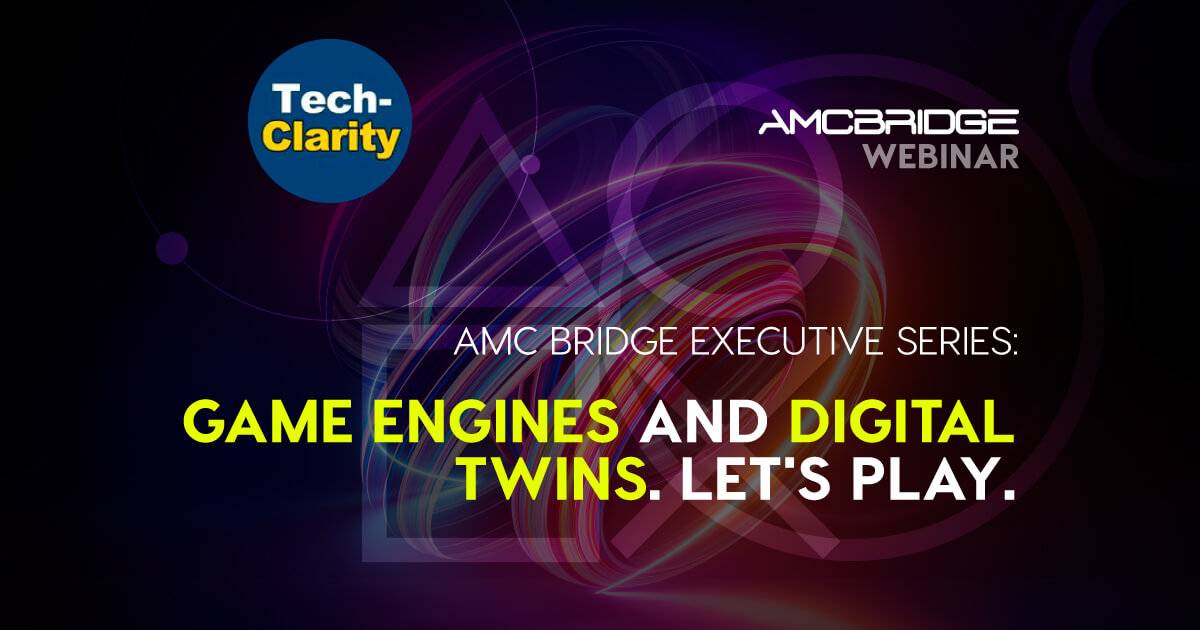 How do digital twins improve the way companies design, engineer, and operate today’s products and buildings? Register for this webinar as Jim Brown hosts a panel of experts to discuss how gaming engines can be applied to improve the business value of digital twins. The speakers will discuss:
How do digital twins improve the way companies design, engineer, and operate today’s products and buildings? Register for this webinar as Jim Brown hosts a panel of experts to discuss how gaming engines can be applied to improve the business value of digital twins. The speakers will discuss:
- How companies use digital twins to improve the way they design, engineer, create, and operate today’s products and built structures
- The business case for immersive, interactive, high-fidelity visualizations and how game engines can help deliver them
- Why game engines are different than existing 3D technologies
- David Craig Weir-McCall, Industry Marketing Manager - Architecture, Epic Games
- Erin Khan, National Director of Construction Solutions, Suffolk Construction
- Elizabeth Baron, Enterprise Solutions Executive, Unity Technologies
- Igor Tsinman, Co-Founder and President, AMC Bridge
- How Software Enables Industrial Additive Manufacturing
- Embracing Cloud Engineering Software and Data
- Digital Twin - Bridging the Gap Between Vision and Reality
- The Role of Simulation Technology in Digital Twins
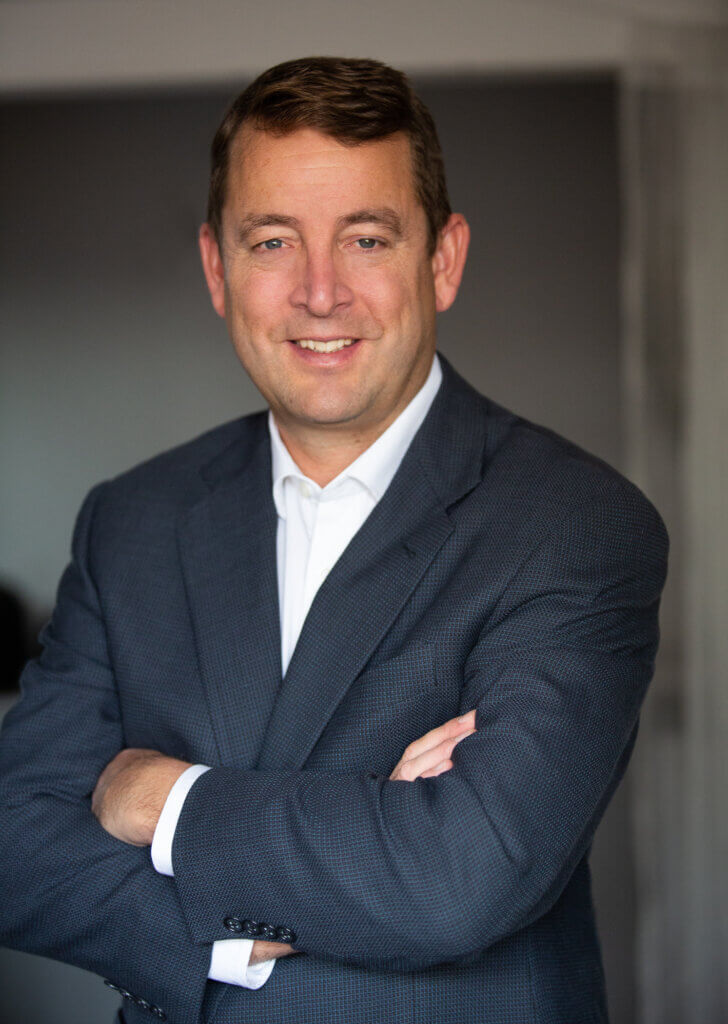
Steffen Waite is the VP of Research for AECO and Industrialized Construction Software for independent research firm Tech-Clarity. His areas of expertise include BIM, digital twin, DfMA, ERP, PM, FM, and leveraging off-site pre-fab solutions for maximum build efficiency.
Steffen has over 30 years of experience, including construction management, product manufacturing, systems development, and virtual design and construction (VDC). After beginning his career as a project manager in building, ICI, and tunnel construction, his senior leadership roles focused on driving strategies around process, common data environments, manufacturing and assembly (DfMA), robotics, and BIM. He has a BASc (Civil Engineering) from the University of Toronto as well as certificates in Management (University of East Anglia) and BIM (University of Washington).
Mr. Waite is a thought leader who thrives on engaging with people with a passion for improving business and sustainability performance through digital enterprise strategies and software technology. His role at Tech-Clarity is to educate portfolio owners, design firms, general contractors, trade contractors, and component manufacturers on the value of technology for the built environment and asset operation.
When he’s not focused on technology, he is an avid mountain enthusiast (hiking, biking, and skiing) and spends time on the water either boating or surfing.
[post_title] => Steffen Waite [post_excerpt] => [post_status] => publish [comment_status] => closed [ping_status] => closed [post_password] => [post_name] => steffen-waite [to_ping] => [pinged] => [post_modified] => 2022-11-14 23:39:11 [post_modified_gmt] => 2022-11-15 04:39:11 [post_content_filtered] => [post_parent] => 24 [guid] => https://tech-clarity.com/?page_id=11754 [menu_order] => -10 [post_type] => page [post_mime_type] => [comment_count] => 0 [filter] => raw ) [10] => WP_Post Object ( [ID] => 11730 [post_author] => 2574 [post_date] => 2022-08-17 22:50:08 [post_date_gmt] => 2022-08-18 02:50:08 [post_content] =>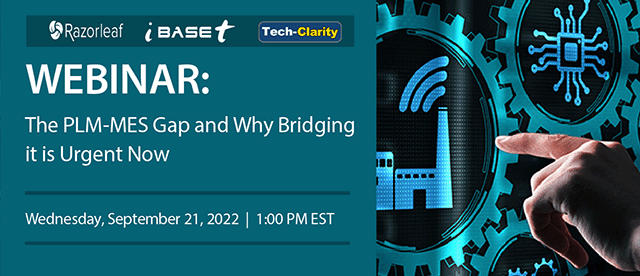 How do you bridge the gulf between product engineering and manufacturing? In the product lifecycle, manufacturing sits at the center. Rapid product and process improvement, lower cost of quality, and business innovation rest on engineering and manufacturing working together effectively. Yet often they don’t or can’t.
Tech-Clarity research shows that MES and PLM are the top two applications Top Performers use to manage manufacturing data. Yet, like the disciplines, they often have a gap between them. That break in the digital thread limits companies’ ability to be truly agile, to innovate at top quality and at minimal cost.
Register to hear iBASEt’s Attila Labas, Razorleaf’s Jonathan Scott, and Tech-Clarity’s Julie Fraser as they discuss the issues and challenges of PLM-MES gap bridging. Download now to hear this recording of the live webinar.
[post_title] => The PLM – MES Gap and Why Bridging it is Urgent Now
[post_excerpt] =>
[post_status] => publish
[comment_status] => open
[ping_status] => open
[post_password] =>
[post_name] => plm-mes-webcast
[to_ping] =>
[pinged] =>
[post_modified] => 2024-01-02 13:19:32
[post_modified_gmt] => 2024-01-02 18:19:32
[post_content_filtered] =>
[post_parent] => 0
[guid] => https://tech-clarity.com/?p=11730
[menu_order] => 0
[post_type] => post
[post_mime_type] =>
[comment_count] => 0
[filter] => raw
)
[11] => WP_Post Object
(
[ID] => 11711
[post_author] => 2
[post_date] => 2022-08-03 08:24:06
[post_date_gmt] => 2022-08-03 12:24:06
[post_content] =>
How do you bridge the gulf between product engineering and manufacturing? In the product lifecycle, manufacturing sits at the center. Rapid product and process improvement, lower cost of quality, and business innovation rest on engineering and manufacturing working together effectively. Yet often they don’t or can’t.
Tech-Clarity research shows that MES and PLM are the top two applications Top Performers use to manage manufacturing data. Yet, like the disciplines, they often have a gap between them. That break in the digital thread limits companies’ ability to be truly agile, to innovate at top quality and at minimal cost.
Register to hear iBASEt’s Attila Labas, Razorleaf’s Jonathan Scott, and Tech-Clarity’s Julie Fraser as they discuss the issues and challenges of PLM-MES gap bridging. Download now to hear this recording of the live webinar.
[post_title] => The PLM – MES Gap and Why Bridging it is Urgent Now
[post_excerpt] =>
[post_status] => publish
[comment_status] => open
[ping_status] => open
[post_password] =>
[post_name] => plm-mes-webcast
[to_ping] =>
[pinged] =>
[post_modified] => 2024-01-02 13:19:32
[post_modified_gmt] => 2024-01-02 18:19:32
[post_content_filtered] =>
[post_parent] => 0
[guid] => https://tech-clarity.com/?p=11730
[menu_order] => 0
[post_type] => post
[post_mime_type] =>
[comment_count] => 0
[filter] => raw
)
[11] => WP_Post Object
(
[ID] => 11711
[post_author] => 2
[post_date] => 2022-08-03 08:24:06
[post_date_gmt] => 2022-08-03 12:24:06
[post_content] => 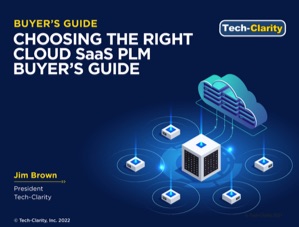 What do manufacturers need to look for as they plan to adopt cloud PLM? Our updated buyer’s guide shares requirements to help manufacturers ensure that their cloud SaaS PLM solution will meet their product innovation and digital transformation needs.
Please enjoy the summary* below. For the full research, please visit our sponsor PTC (registration required).
For related research, please read some of our related buyer's guides, including How to Choose the Right PDM System and Choosing the Right PLM for the Medical Device Digital Thread.
What do manufacturers need to look for as they plan to adopt cloud PLM? Our updated buyer’s guide shares requirements to help manufacturers ensure that their cloud SaaS PLM solution will meet their product innovation and digital transformation needs.
Please enjoy the summary* below. For the full research, please visit our sponsor PTC (registration required).
For related research, please read some of our related buyer's guides, including How to Choose the Right PDM System and Choosing the Right PLM for the Medical Device Digital Thread.
Table of Contents
- Cloud PLM Adoption Questions Shift
- Increase the Value of PLM with SaaS
- Buyer's Considerations
- Review Deployment Options
- Considerations for Adoption
- Evaluate Pricing Options
- Product Development Needs
- Operational Considerations
- Choosing the Right PLM
- Choose the Right Partner
- Special Considerations
- Conclusions and Recommendations
- Acknowledgments
PLM is the Digital Backbone for Manufacturing
Considerations for Digital Transformation with PLM The pace of business is accelerating and companies must digitally transform to compete. Our research finds that PLM is critical to manufacturers’ digital transformations and initiatives including the digital twin and the digital thread. Today’s PLM system must serve as the product backbone of the digital manufacturing enterprise. But too many companies are stuck on old, outdated versions of their PLM system or need to move to the cloud to support their goals. Cloud SaaS can provide the modern, full featured PLM capabilities companies need while increasing agility, speed, collaboration, performance, availability, and security and simultaneously reducing cost, time to value, risk, and IT overhead. Not all “cloud” solutions, however, support digital transformation in the same way. Manufacturers should closely examine their requirements and be careful not to trade off essential PLM capabilities to meet those requirements.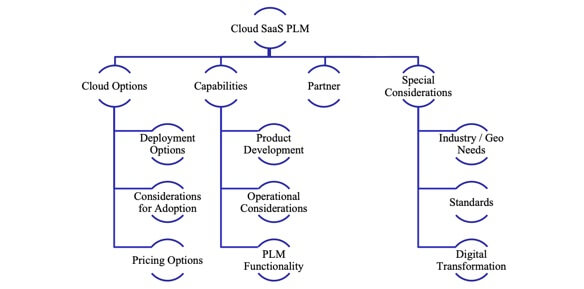
Cloud PLM Adoption Questions Shift
The Shift from “If” Cloud PLM to “When and How” As recently as our 2019 buyer’s guide we observed that more companies were starting to ask “why not the cloud?” instead of “why consider cloud?” Although some companies and industries may still have obstacles that prevent them from moving to the cloud, cloud PLM solutions are quickly becoming the preferred approach. Our research shows that over one-half of manufacturers are considering cloud and about one-quarter already leverage the cloud to support product innovation and manufacturing1. Now the questions are “when and how?” to adopt Cloud PLM. Navigating the Options Choosing to move to the cloud is just the first step. There are still important decisions to make. The deployment choice impacts important factors including cost, security, resource requirements, performance, availability, upgradability, risk, and time to benefit. While it’s clear that the software industry is moving to a cloud SaaS model overall, not all cloud PLM solutions are following that model. Manufacturers need to go deeper into the deployment model than just “cloud.” This guide helps companies navigate the options and choose the best-suited cloud PLM solution for their business. Still a Solution First Approach Although the priority for cloud solutions has increased, our surveys still show that the majority of companies put a higher priority on PLM capabilities than cloud deployment. They recognize that they don’t just need a cloud PLM system, they need a fully-featured PLM system on the cloud. Over ½ of companies stated that they were willing to give up “very little” or “no” functionality as a tradeoff for the IT benefits of the cloud.2 Companies are still not willing to shortchange functionality in this crucial area, effectively taking a “solution first” approach as opposed to a “cloud first.” Therefore, it’s important to evaluate the functional capabilities of a PLM system to ensure it will deliver the significant top- and bottom-line benefits they need from PLM.Conclusions and Recommendations
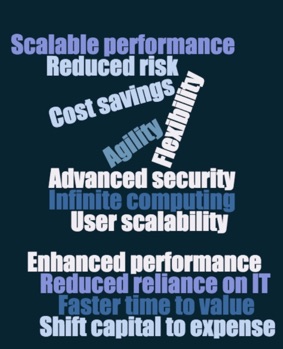 Cloud SaaS Offers Compelling Benefits
Cloud SaaS helps manufacturers achieve and extend the significant business value of PLM faster, with less risk, and lower total cost of ownership. It offers new opportunities to enhance global reach, secure design sharing, and collaboration. At the same time, it offers compelling operational benefits such as improved performance, security, access to new functionality, and scalability. But there are important things to consider when selecting a cloud PLM system, ranging from deployment options to considerations for certain industries and geographies.
Recommendations for Cloud PLM Selection
To help companies research and analyze potential solutions based on company needs, including needs that help deliver benefits well into the future, Tech-Clarity offers the following recommendations:
Cloud SaaS Offers Compelling Benefits
Cloud SaaS helps manufacturers achieve and extend the significant business value of PLM faster, with less risk, and lower total cost of ownership. It offers new opportunities to enhance global reach, secure design sharing, and collaboration. At the same time, it offers compelling operational benefits such as improved performance, security, access to new functionality, and scalability. But there are important things to consider when selecting a cloud PLM system, ranging from deployment options to considerations for certain industries and geographies.
Recommendations for Cloud PLM Selection
To help companies research and analyze potential solutions based on company needs, including needs that help deliver benefits well into the future, Tech-Clarity offers the following recommendations:
- Evaluate functional solution capabilities to ensure that the PLM solution provides the rich capabilities required to support your business.
- Recognize that there are significant differences in “cloud” PLM offerings.
- Evaluate and select the optimal deployment and pricing models that give your business the most benefit considering cost, risk, and time to achieve value.
- Consider how the deployment approach will impact future financial and operational value during updates, upgrades, and extensions
- Consider the strategic value of cloud solutions for global deployments to support global design environments, remote workers, and secure supply chain collaboration.
- Make sure to consider the future, including the transition to the digital enterprise. We believe that manufacturers that don’t digitally transform will be at a competitive disadvantage.
- Narrow down solutions based on these high-level criteria to create a smaller list of solutions to evaluate.
- Recognize that any solution selection process will require tradeoffs and understand which types of requirements are the most important to your company’s success and profitability.
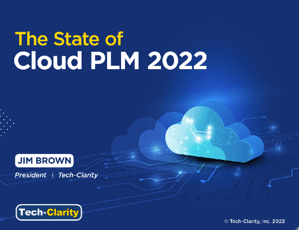 Companies are making a significant shift to the cloud, how is that impacting PLM? What do manufacturers need to be aware of related to features, customization, and upgrades as they make the transition? Our survey results include insights from over one hundred manufacturers to find out.
Please enjoy the summary below.* For the full report, please visit our sponsor Aras (registration required).
For related content, watch the interactive webinar replay where Jim Brown shares in-depth insights from his conversations with customers.
Companies are making a significant shift to the cloud, how is that impacting PLM? What do manufacturers need to be aware of related to features, customization, and upgrades as they make the transition? Our survey results include insights from over one hundred manufacturers to find out.
Please enjoy the summary below.* For the full report, please visit our sponsor Aras (registration required).
For related content, watch the interactive webinar replay where Jim Brown shares in-depth insights from his conversations with customers.
Table of Contents
- PLM is Moving to the Cloud
- Cloud Transformation Patience is Over
- Current State of PLM Boosts Cloud Opportunity
- Take an Objective Look at Customization
- Plan for the Reality of Customization
- Understand Upgrade Processes
- Ensure PLM Delivers Business Value
- Conclusions
- About the Research
- Acknowledgments
Cloud PLM Adoption Accelerating
Develop Cloud Transition Strategy Companies are making a significant shift to cloud software. To get a clearer picture of the manufacturing industry’s current state and future plans for cloud PLM, Tech-Clarity surveyed over one hundred larger manufacturers with over 500 employees. Survey results show that cloud PLM adoption is accelerating and becoming the norm. Understand Implications Manufacturers favor cloud solutions and the majority now use, or plan to use, cloud PLM. Although most companies are familiar with the benefits of the cloud, not all companies understand the implications of cloud deployment model and architecture choices. In particular, this survey examines several important considerations for ensuring they drive business value from their PLM implementation, including the impacts on:- Features needed to reach business goals
- Customization to achieve business value and ensure user adoption
- Upgrade timing to access innovation while remaining compliant
PLM is Moving to the Cloud
 Manufacturers Now Favor the Cloud
The shift to cloud software is a relatively recent, fundamental shift in IT architecture. Only 17% of companies participating in our 2018 study1 had a software strategy that called for only using the cloud, using the cloud unless no capable solution was available, or preferring the cloud. Instead, over one-third would choose the most capable solution and about one-quarter did not consider or allow the cloud.
The 2022 survey reflects a dramatically different climate. Now, about three-quarters of companies favor, prefer, or mandate the cloud for their new software selections. In fact, only 4% of responding companies say they do not consider or allow the cloud.
PLM Cloud Transformation has Accelerated
Those results detail companies’ overall cloud strategy, but how does that relate to PLM? PLM adoption has traditionally lagged behind other enterprise software solutions. While some attributed lower adoption to security concerns, we believe it was because companies were forced to choose between cloud solutions or fully-featured PLM. Either way, it’s clear that the PLM transformation is now picking up pace. Almost three-quarters of surveyed companies are either using cloud PLM or to planning to do so. Very few, on the other hand, are unwilling to use the cloud. Our experience shows that this is likely due to regulatory or customer mandates.
Manufacturers Now Favor the Cloud
The shift to cloud software is a relatively recent, fundamental shift in IT architecture. Only 17% of companies participating in our 2018 study1 had a software strategy that called for only using the cloud, using the cloud unless no capable solution was available, or preferring the cloud. Instead, over one-third would choose the most capable solution and about one-quarter did not consider or allow the cloud.
The 2022 survey reflects a dramatically different climate. Now, about three-quarters of companies favor, prefer, or mandate the cloud for their new software selections. In fact, only 4% of responding companies say they do not consider or allow the cloud.
PLM Cloud Transformation has Accelerated
Those results detail companies’ overall cloud strategy, but how does that relate to PLM? PLM adoption has traditionally lagged behind other enterprise software solutions. While some attributed lower adoption to security concerns, we believe it was because companies were forced to choose between cloud solutions or fully-featured PLM. Either way, it’s clear that the PLM transformation is now picking up pace. Almost three-quarters of surveyed companies are either using cloud PLM or to planning to do so. Very few, on the other hand, are unwilling to use the cloud. Our experience shows that this is likely due to regulatory or customer mandates.
Conclusions
 The Transition is Underway
A fundamental cloud PLM transition is underway and has accelerated. Despite a slower start than some other applications like ERP or CRM, manufacturers are rapidly pursuing cloud PLM solutions. Cloud PLM offers significant benefits, and companies appear to have transitioned from deciding “if” to implement a cloud solution for PLM and now are discussing “when” and “how.”
Cloud Transformation Offers Additional Improvement Opportunities
In addition to cloud benefits, the large number of companies planning to replace their PLM system with a cloud offering can benefit from a “reset” if their PLM system does not move to the cloud quickly enough. This reset may be valuable because the common state of PLM hampers progress and value due to:
The Transition is Underway
A fundamental cloud PLM transition is underway and has accelerated. Despite a slower start than some other applications like ERP or CRM, manufacturers are rapidly pursuing cloud PLM solutions. Cloud PLM offers significant benefits, and companies appear to have transitioned from deciding “if” to implement a cloud solution for PLM and now are discussing “when” and “how.”
Cloud Transformation Offers Additional Improvement Opportunities
In addition to cloud benefits, the large number of companies planning to replace their PLM system with a cloud offering can benefit from a “reset” if their PLM system does not move to the cloud quickly enough. This reset may be valuable because the common state of PLM hampers progress and value due to:
- Outdated PLM systems that have not been recently upgraded, resulting in missed opportunity to take advantage of functional and technical enhancement opportunities. Our experience shows this is frequently due to dead-end customization approaches that make upgrades extremely challenging.
- Multiple PLM systems, leading to high cost and operational disadvantages that limit PLM value.
- The need and ability to customize PLM
- The requirements and limitations related to controlling PLM upgrade timing
- The ability to deliver the rich PLM capabilities they need to deliver value
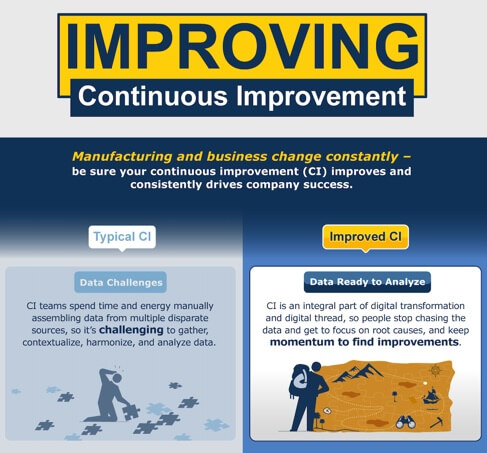 [post_title] => Improving Continuous Improvement
[post_excerpt] =>
[post_status] => publish
[comment_status] => open
[ping_status] => open
[post_password] =>
[post_name] => improving-continuous-improvement-infographic
[to_ping] =>
[pinged] =>
[post_modified] => 2024-01-02 13:22:22
[post_modified_gmt] => 2024-01-02 18:22:22
[post_content_filtered] =>
[post_parent] => 0
[guid] => https://tech-clarity.com/?p=11693
[menu_order] => 0
[post_type] => post
[post_mime_type] =>
[comment_count] => 0
[filter] => raw
)
[14] => WP_Post Object
(
[ID] => 11660
[post_author] => 2
[post_date] => 2022-07-25 09:30:08
[post_date_gmt] => 2022-07-25 13:30:08
[post_content] =>
[post_title] => Improving Continuous Improvement
[post_excerpt] =>
[post_status] => publish
[comment_status] => open
[ping_status] => open
[post_password] =>
[post_name] => improving-continuous-improvement-infographic
[to_ping] =>
[pinged] =>
[post_modified] => 2024-01-02 13:22:22
[post_modified_gmt] => 2024-01-02 18:22:22
[post_content_filtered] =>
[post_parent] => 0
[guid] => https://tech-clarity.com/?p=11693
[menu_order] => 0
[post_type] => post
[post_mime_type] =>
[comment_count] => 0
[filter] => raw
)
[14] => WP_Post Object
(
[ID] => 11660
[post_author] => 2
[post_date] => 2022-07-25 09:30:08
[post_date_gmt] => 2022-07-25 13:30:08
[post_content] => 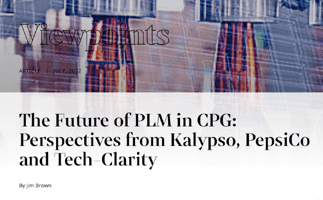 What does the future look like for PLM in the CPG industry? Tech-Clarity led an interactive discussion with Pepsico and Kalypso PLM leaders in a Kalypso-hosted webinar. It was an interactive discussion with PLM industry leaders from a variety of roles to discuss the findings of our recent research on the Future of PLM in CPG.
The panel brought together over six decades of PLM experience from industry, trusted advisors, and research perspectives. The panel, hosted by Kalypso's Consumer Industry Marketing Manager Hadley Bauer, consisted of:
What does the future look like for PLM in the CPG industry? Tech-Clarity led an interactive discussion with Pepsico and Kalypso PLM leaders in a Kalypso-hosted webinar. It was an interactive discussion with PLM industry leaders from a variety of roles to discuss the findings of our recent research on the Future of PLM in CPG.
The panel brought together over six decades of PLM experience from industry, trusted advisors, and research perspectives. The panel, hosted by Kalypso's Consumer Industry Marketing Manager Hadley Bauer, consisted of:
- Susan Hamel, PepsiCo's Senior Director of Global R&D, shared her experience in advancing the PLM agenda over the last 20 years
- Colin Speakman, Kalypso's Consumer Goods Global Director, offered his experience, knowledge, and strong relationships with CPG companies
- Jim Brown, Tech-Clarity's President of Product Innovation and Digital Transformation Research
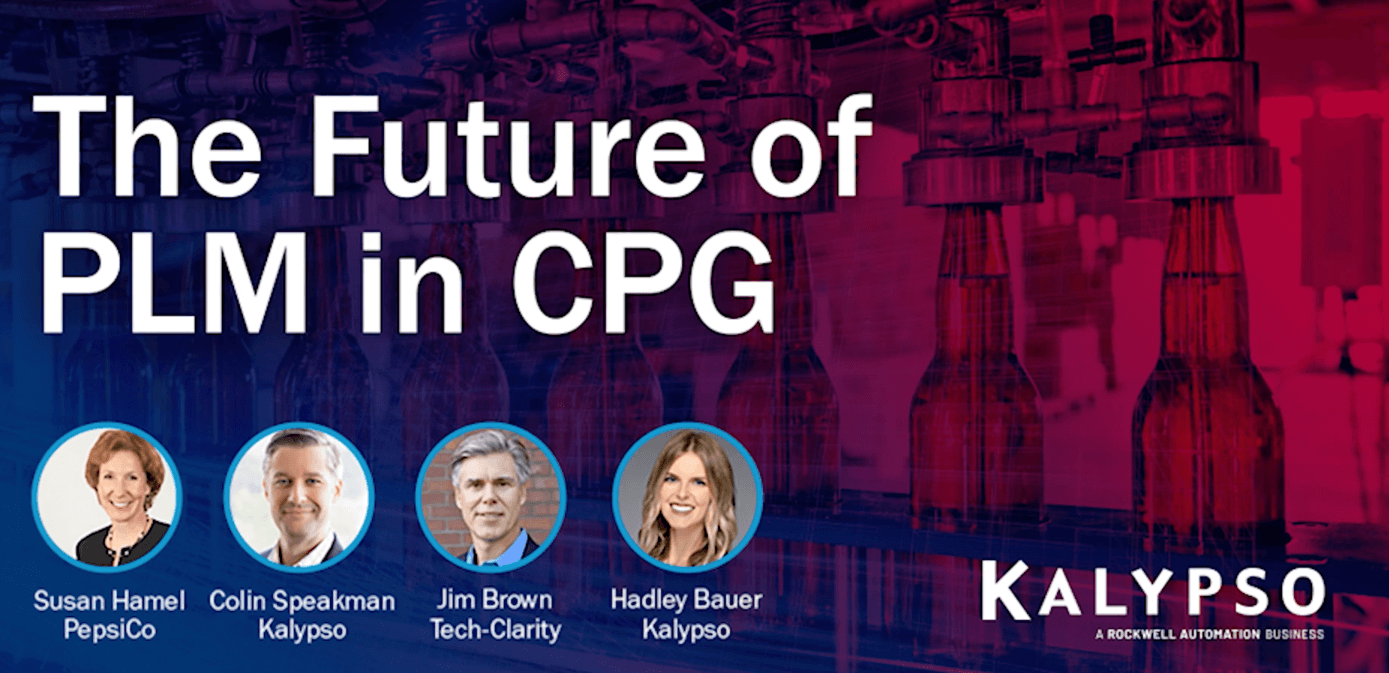 [post_title] => Future of CPG PLM with Kalypso and Pepsico
[post_excerpt] =>
[post_status] => publish
[comment_status] => open
[ping_status] => open
[post_password] =>
[post_name] => cpg-plm-blog
[to_ping] =>
[pinged] =>
[post_modified] => 2023-12-15 16:35:14
[post_modified_gmt] => 2023-12-15 21:35:14
[post_content_filtered] =>
[post_parent] => 0
[guid] => https://tech-clarity.com/?p=11660
[menu_order] => 0
[post_type] => post
[post_mime_type] =>
[comment_count] => 0
[filter] => raw
)
[15] => WP_Post Object
(
[ID] => 11650
[post_author] => 2574
[post_date] => 2022-07-19 10:37:40
[post_date_gmt] => 2022-07-19 14:37:40
[post_content] =>
[post_title] => Future of CPG PLM with Kalypso and Pepsico
[post_excerpt] =>
[post_status] => publish
[comment_status] => open
[ping_status] => open
[post_password] =>
[post_name] => cpg-plm-blog
[to_ping] =>
[pinged] =>
[post_modified] => 2023-12-15 16:35:14
[post_modified_gmt] => 2023-12-15 21:35:14
[post_content_filtered] =>
[post_parent] => 0
[guid] => https://tech-clarity.com/?p=11660
[menu_order] => 0
[post_type] => post
[post_mime_type] =>
[comment_count] => 0
[filter] => raw
)
[15] => WP_Post Object
(
[ID] => 11650
[post_author] => 2574
[post_date] => 2022-07-19 10:37:40
[post_date_gmt] => 2022-07-19 14:37:40
[post_content] =>  How can strategic sourcing professionals lower risk and cost in these uncertain times? This new paper by Procurement Leaders points to the potential of AI in a marketplace, and quotes Tech-Clarity’s Julie Fraser.
Please enjoy the summary* below. For the full research, please visit Procurement Leaders (registration required).
Materials price increases and supplier risk have not abated since the start of the COVID-19 pandemic. Traditional procurement automation systems do not address those issues effectively. Thus, companies must find new ways to combat what appears to be a permanent situation.
“Flipping the pyramid” to use mostly external data and combine internal data with it may hold the key. Marketplaces are once again taking the stage, and with advanced analytics behind them, the benefits are significant. This paper has a concrete example from Bose.
Electronics is an example of an industry where many suppliers and parts are used by a multitude of companies, and available both direct from the manufacturer and from distributors. This makes it ideal for such a marketplace approach.
Fraser points out that near real-time data about supply and logistics from outside still needs a way to get into context with internal data for analytics to perform. If a platform allows that, it can truly push out insights that lead to decisions for how to improve costs and reduce risk.
Read the report to learn more. Thanks, Malcolm Wheatley for the opportunity to share our point of view along with many luminaries.
For related research with Julie Fraser, please read Procurement automation: advancing to the future.
[post_title] => Strategic Sourcing: Leverage AI to Mitigate Risk and Cut Costs (quote spotlight)
[post_excerpt] =>
[post_status] => publish
[comment_status] => open
[ping_status] => open
[post_password] =>
[post_name] => sourcing-risk-and-cost-paper
[to_ping] =>
[pinged] =>
[post_modified] => 2022-11-14 22:25:58
[post_modified_gmt] => 2022-11-15 03:25:58
[post_content_filtered] =>
[post_parent] => 0
[guid] => https://tech-clarity.com/?p=11650
[menu_order] => 0
[post_type] => post
[post_mime_type] =>
[comment_count] => 0
[filter] => raw
)
[16] => WP_Post Object
(
[ID] => 17732
[post_author] => 2574
[post_date] => 2022-07-16 09:47:24
[post_date_gmt] => 2022-07-16 13:47:24
[post_content] => What can manufacturers do to gain full business value from IIoT investments? Julie Fraser shares three tips to create a firm foundation for success on The Peggy Smedley Show podcast.
Hear four examples of how new technology infrastructure and architecture can support bridging the IT/OT divide. Plus a focus on process improvement and people. All of these can deliver strong IIoT business value - if you stay focused on them. Listen to this in this episode to get some ideas for what you might do to better ensure IIoT projects deliver business benefits.
How can strategic sourcing professionals lower risk and cost in these uncertain times? This new paper by Procurement Leaders points to the potential of AI in a marketplace, and quotes Tech-Clarity’s Julie Fraser.
Please enjoy the summary* below. For the full research, please visit Procurement Leaders (registration required).
Materials price increases and supplier risk have not abated since the start of the COVID-19 pandemic. Traditional procurement automation systems do not address those issues effectively. Thus, companies must find new ways to combat what appears to be a permanent situation.
“Flipping the pyramid” to use mostly external data and combine internal data with it may hold the key. Marketplaces are once again taking the stage, and with advanced analytics behind them, the benefits are significant. This paper has a concrete example from Bose.
Electronics is an example of an industry where many suppliers and parts are used by a multitude of companies, and available both direct from the manufacturer and from distributors. This makes it ideal for such a marketplace approach.
Fraser points out that near real-time data about supply and logistics from outside still needs a way to get into context with internal data for analytics to perform. If a platform allows that, it can truly push out insights that lead to decisions for how to improve costs and reduce risk.
Read the report to learn more. Thanks, Malcolm Wheatley for the opportunity to share our point of view along with many luminaries.
For related research with Julie Fraser, please read Procurement automation: advancing to the future.
[post_title] => Strategic Sourcing: Leverage AI to Mitigate Risk and Cut Costs (quote spotlight)
[post_excerpt] =>
[post_status] => publish
[comment_status] => open
[ping_status] => open
[post_password] =>
[post_name] => sourcing-risk-and-cost-paper
[to_ping] =>
[pinged] =>
[post_modified] => 2022-11-14 22:25:58
[post_modified_gmt] => 2022-11-15 03:25:58
[post_content_filtered] =>
[post_parent] => 0
[guid] => https://tech-clarity.com/?p=11650
[menu_order] => 0
[post_type] => post
[post_mime_type] =>
[comment_count] => 0
[filter] => raw
)
[16] => WP_Post Object
(
[ID] => 17732
[post_author] => 2574
[post_date] => 2022-07-16 09:47:24
[post_date_gmt] => 2022-07-16 13:47:24
[post_content] => What can manufacturers do to gain full business value from IIoT investments? Julie Fraser shares three tips to create a firm foundation for success on The Peggy Smedley Show podcast.
Hear four examples of how new technology infrastructure and architecture can support bridging the IT/OT divide. Plus a focus on process improvement and people. All of these can deliver strong IIoT business value - if you stay focused on them. Listen to this in this episode to get some ideas for what you might do to better ensure IIoT projects deliver business benefits.

[post_title] => Three Tips to Ensure IIoT Delivers Business Value [post_excerpt] => [post_status] => publish [comment_status] => open [ping_status] => open [post_password] => [post_name] => iiot-business-value [to_ping] => [pinged] => [post_modified] => 2024-01-02 13:31:10 [post_modified_gmt] => 2024-01-02 18:31:10 [post_content_filtered] => [post_parent] => 0 [guid] => https://tech-clarity.com/?p=17732 [menu_order] => 0 [post_type] => post [post_mime_type] => [comment_count] => 0 [filter] => raw ) [17] => WP_Post Object ( [ID] => 11633 [post_author] => 2572 [post_date] => 2022-07-13 09:00:13 [post_date_gmt] => 2022-07-13 13:00:13 [post_content] =>
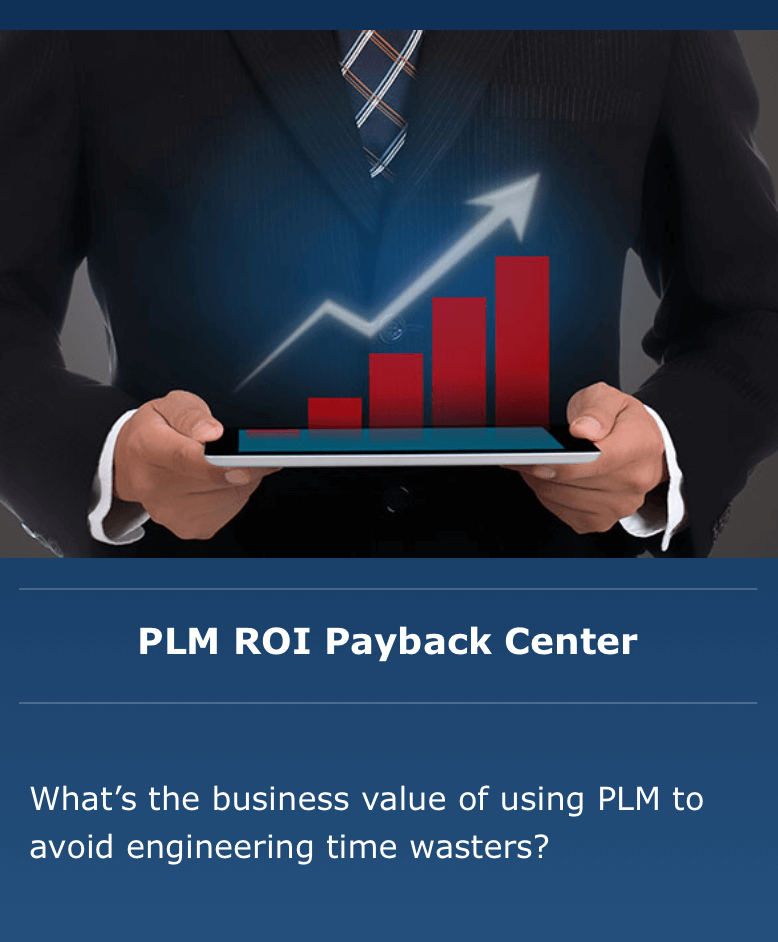 What can you expect for PLM ROI? How will it help your business?
Engineers waste a lot of valuable time on non-value-added work. However, our research finds that Product Lifecycle Management (PLM) can help. It provides business value by empowering engineers to focus more of their valuable time on innovation, design, and engineering. Still, how can it help YOUR company?
Tech-Clarity's 5-minute online assessment leverages our research to help you assess and predict the business value of PLM at your company so that you will have a better understanding of PLM's Return on Investment (ROI).
What can you expect for PLM ROI? How will it help your business?
Engineers waste a lot of valuable time on non-value-added work. However, our research finds that Product Lifecycle Management (PLM) can help. It provides business value by empowering engineers to focus more of their valuable time on innovation, design, and engineering. Still, how can it help YOUR company?
Tech-Clarity's 5-minute online assessment leverages our research to help you assess and predict the business value of PLM at your company so that you will have a better understanding of PLM's Return on Investment (ROI).
The Online Assessment
This online assessment asks a few questions to understand the goals of your business, your development environment, your top challenge, and the complexity of your products. It then calculates the expected time and cost savings, plus increased revenue opportunities, based on the experiences of companies that develop similarly complex products. In addition to the calculated values, the assessment produces a customized report explaining how PLM can help your company meet its top goals and solve your biggest challenge. Take the online assessment here. You will also have the option to save, print, and share the results. Learn more about Teamcenter PLM from our sponsor, Siemens. For related research, you may be interested in our eBook, The Business Value of Reducing Engineering Time Wasters.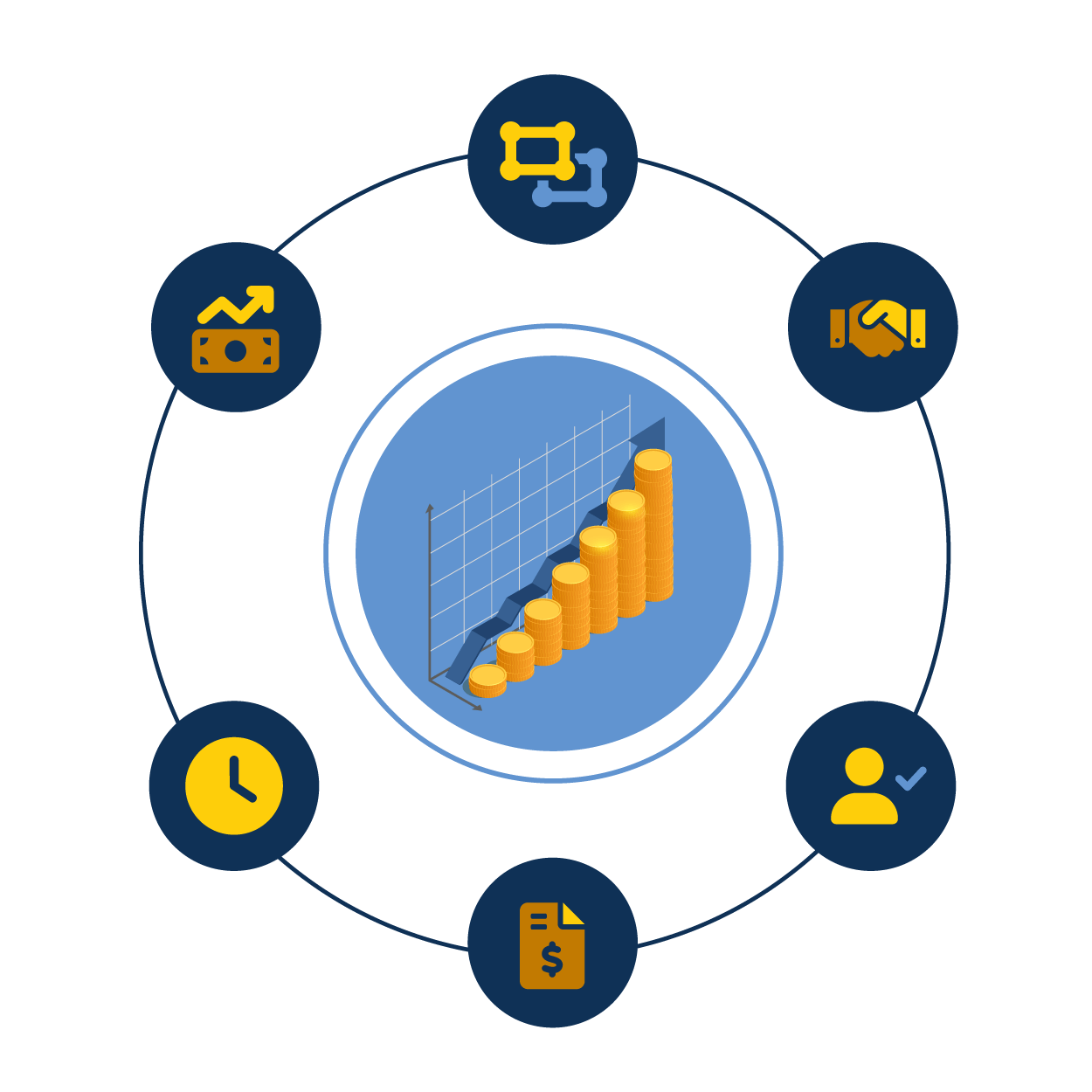 [post_title] => PLM ROI Payback
[post_excerpt] =>
[post_status] => publish
[comment_status] => open
[ping_status] => open
[post_password] =>
[post_name] => plm-roi-calculator-assessment
[to_ping] =>
[pinged] =>
[post_modified] => 2023-12-15 13:17:06
[post_modified_gmt] => 2023-12-15 18:17:06
[post_content_filtered] =>
[post_parent] => 0
[guid] => https://tech-clarity.com/?p=11633
[menu_order] => 0
[post_type] => post
[post_mime_type] =>
[comment_count] => 0
[filter] => raw
)
[18] => WP_Post Object
(
[ID] => 11616
[post_author] => 2572
[post_date] => 2022-07-12 09:00:26
[post_date_gmt] => 2022-07-12 13:00:26
[post_content] =>
[post_title] => PLM ROI Payback
[post_excerpt] =>
[post_status] => publish
[comment_status] => open
[ping_status] => open
[post_password] =>
[post_name] => plm-roi-calculator-assessment
[to_ping] =>
[pinged] =>
[post_modified] => 2023-12-15 13:17:06
[post_modified_gmt] => 2023-12-15 18:17:06
[post_content_filtered] =>
[post_parent] => 0
[guid] => https://tech-clarity.com/?p=11633
[menu_order] => 0
[post_type] => post
[post_mime_type] =>
[comment_count] => 0
[filter] => raw
)
[18] => WP_Post Object
(
[ID] => 11616
[post_author] => 2572
[post_date] => 2022-07-12 09:00:26
[post_date_gmt] => 2022-07-12 13:00:26
[post_content] =>  What should you consider to ensure your MBE strategy is successful?
Manufacturers adopting a Model-Based Enterprise (MBE) strategy report improved traceability and agility, faster delivery, greater efficiency, and lower costs. What should you consider to realize similar benefits? An MBE is an organization that uses digital models to support commissioning, operating, servicing, and decommissioning a product, thereby eliminating many of the process and coordination challenges associated with managing products with paper-based, manual processes throughout their lifecycle.
Adopting a Model-Based Enterprise (MBE) Strategy? What You Should Know, a research report based on a survey of 250 discrete manufacturers, establishes a "state of the market" for MBE adoption. In addition, it identifies best practices and considerations to help you progress to higher maturity levels during your MBE adoption journey. This understanding should help manufacturers better plan and prepare for the journey by leveraging people, process, and technology to maximize return on investment as early as possible.
Please enjoy the summary below.* For the full report, please visit our sponsor iBASEt (registration required).
What should you consider to ensure your MBE strategy is successful?
Manufacturers adopting a Model-Based Enterprise (MBE) strategy report improved traceability and agility, faster delivery, greater efficiency, and lower costs. What should you consider to realize similar benefits? An MBE is an organization that uses digital models to support commissioning, operating, servicing, and decommissioning a product, thereby eliminating many of the process and coordination challenges associated with managing products with paper-based, manual processes throughout their lifecycle.
Adopting a Model-Based Enterprise (MBE) Strategy? What You Should Know, a research report based on a survey of 250 discrete manufacturers, establishes a "state of the market" for MBE adoption. In addition, it identifies best practices and considerations to help you progress to higher maturity levels during your MBE adoption journey. This understanding should help manufacturers better plan and prepare for the journey by leveraging people, process, and technology to maximize return on investment as early as possible.
Please enjoy the summary below.* For the full report, please visit our sponsor iBASEt (registration required).
Table of Contents
- Executive Summary
- MBE Definition
- Adopting MBE
- Top Performers
- Maturity Index
- MBE Impact
- Adoption Challenges
- Recommendations
- About the Research
- Acknowledgments
The MBE Vision
Realizing the Vision The ultimate vision for MBE is for every function to leverage the product model across the entire product lifecycle (see graphic). However, this vision will take time to realize. By planning for it now, your company can start experiencing some of the early benefits, but it can be tricky figuring out how to get started. This eBook provides guidance to help you begin, proceed along the journey, and anticipate potential challenges that could inhibit progress.
Adoption Conclusions
Challenges Evolve As companies start their journey, they run into many process challenges. However, as they work through it, process is less likely to be a top challenge. On the other hand, technology is less of an adoption hurdle early on. However, as the journey progresses and companies automate more, technology plays a more prominent role and it becomes a bigger challenge. Overall, the people and culture challenges are the biggest adoption hurdle, regardless of where companies are in the journey. Success Considerations Do not let technology concerns hold you back as you start the MBE journey. MBE offers benefits early on, while technology does not become a bigger issue until later.
Upfront, think more about process. This is an opportunity to modernize and rethink how processes should work without the limitations of current approaches. Today's environment and products have evolved significantly, so processes developed decades ago will likely hold you back.
Do not overlook people and culture changes. Executive support is critical, and training needs must be addressed regularly throughout the journey. Employees need to understand the value of the new approach, why it is better for them, and how it will help them do an even better job, in less time, with higher quality.
Vendors who have a strong vision for MBE can be a great asset. Those involved in standards organizations such as NIST will likely support the latest standards. Look for software solutions that will leverage semantic PMI to automate work.
Do not let technology concerns hold you back as you start the MBE journey. MBE offers benefits early on, while technology does not become a bigger issue until later.
Upfront, think more about process. This is an opportunity to modernize and rethink how processes should work without the limitations of current approaches. Today's environment and products have evolved significantly, so processes developed decades ago will likely hold you back.
Do not overlook people and culture changes. Executive support is critical, and training needs must be addressed regularly throughout the journey. Employees need to understand the value of the new approach, why it is better for them, and how it will help them do an even better job, in less time, with higher quality.
Vendors who have a strong vision for MBE can be a great asset. Those involved in standards organizations such as NIST will likely support the latest standards. Look for software solutions that will leverage semantic PMI to automate work.
Recommendations
Recommendations and Next Steps Based on industry experience and research for this report, Tech-Clarity offers the following recommendations to adopt an MBE strategy:- Use MBE as an opportunity to rethink your business operations to enable greater efficiency, lower cost, and improve quality while better serving your customers.
- Consider using the MBE Maturity Index as a framework to guide your adoption journey.
- Ensure executives are involved enough to provide support and leadership as needed.
- Establish new processes structured around a 3D model to help overcome ingrained 2D processes.
- Use CAD tools with more mature capabilities for model-based product definitions, MBD.
- Work with software vendors who have a vision for how Operations should leverage semantic PMI. Keep in mind, MBE spans multiple domains and includes solutions for Engineering, Manufacturing, and Quality.
- Use vendors who are involved with standards organizations so that you can benefit from the best practices developed by these independent organizations.
- Do not overlook the people challenges. Meeting training needs and ensuring all staff understand the business value and benefit to them will be critical to overcome the cultural resistance to change. This should be an ongoing consideration, especially as new technology is introduced throughout the entire journey.
 What has changed in the past 30 years of manufacturing? Listen to the Manufacturing IT Podcast episode where Julie Fraser shares her thoughts with host Daniel Langley. We wander through topics from cigars and sexism to rebranding manufacturing
and remaking companies to be more customer-centric and serious about ESG to overcome the skills shortage. You’ll hear the excitement of myriad new technologies allowing visions of data-driven operations coming to reality. We touch on research and why technology matters to businesses.
Watch the podcast on YouTube or listen on Apple Music.
[post_title] => Julie Fraser on The Manufacturing IT Podcast with Daniel Langley
[post_excerpt] =>
[post_status] => publish
[comment_status] => open
[ping_status] => open
[post_password] =>
[post_name] => manufacturing-it-podcast
[to_ping] =>
[pinged] =>
[post_modified] => 2022-11-14 22:25:58
[post_modified_gmt] => 2022-11-15 03:25:58
[post_content_filtered] =>
[post_parent] => 0
[guid] => https://tech-clarity.com/?p=11601
[menu_order] => 0
[post_type] => post
[post_mime_type] =>
[comment_count] => 0
[filter] => raw
)
)
[post_count] => 20
[current_post] => -1
[before_loop] => 1
[in_the_loop] =>
[post] => WP_Post Object
(
[ID] => 17772
[post_author] => 2
[post_date] => 2022-10-15 12:00:36
[post_date_gmt] => 2022-10-15 16:00:36
[post_content] =>
What has changed in the past 30 years of manufacturing? Listen to the Manufacturing IT Podcast episode where Julie Fraser shares her thoughts with host Daniel Langley. We wander through topics from cigars and sexism to rebranding manufacturing
and remaking companies to be more customer-centric and serious about ESG to overcome the skills shortage. You’ll hear the excitement of myriad new technologies allowing visions of data-driven operations coming to reality. We touch on research and why technology matters to businesses.
Watch the podcast on YouTube or listen on Apple Music.
[post_title] => Julie Fraser on The Manufacturing IT Podcast with Daniel Langley
[post_excerpt] =>
[post_status] => publish
[comment_status] => open
[ping_status] => open
[post_password] =>
[post_name] => manufacturing-it-podcast
[to_ping] =>
[pinged] =>
[post_modified] => 2022-11-14 22:25:58
[post_modified_gmt] => 2022-11-15 03:25:58
[post_content_filtered] =>
[post_parent] => 0
[guid] => https://tech-clarity.com/?p=11601
[menu_order] => 0
[post_type] => post
[post_mime_type] =>
[comment_count] => 0
[filter] => raw
)
)
[post_count] => 20
[current_post] => -1
[before_loop] => 1
[in_the_loop] =>
[post] => WP_Post Object
(
[ID] => 17772
[post_author] => 2
[post_date] => 2022-10-15 12:00:36
[post_date_gmt] => 2022-10-15 16:00:36
[post_content] =>  I had the chance to check in with Propel to get an update on their Product Value Management (PVM) strategy. I’m usually not a big fan of new acronyms, but they really are talking about something more than the current state of PLM. When I started researching PLM (two decades ago, yikes), I developed a comprehensive framework for what the solution could and should be. At the time, it was influenced quite a bit by consumer-oriented new product development (NPD) processes, where NPD needed to expand to NPDI (adding introduction). Few, if any, PLM vendors had that vision, and I would propose that none fully delivered on the promise. Propel is now realizing that vision. The key difference is filling what they call the “product value gap” between product and commercial teams. Propel’s strategy goes beyond what I envisioned, though, focusing on a comprehensive customer experience that spans products and product experiences. It includes three pillars: Defining the product, product operations, and market engagement. It fits the times and how consumers want to engage with products and companies. Propel is led by strategic, visionary thinkers, including Ray Hein, and has the strong support of Salesforce. Keep your eyes on them. If anyone can shake up the industry and move it beyond PLM to PVM it’s probably them. Thanks Tom Shoemaker for sharing the vision with me.
I had the chance to check in with Propel to get an update on their Product Value Management (PVM) strategy. I’m usually not a big fan of new acronyms, but they really are talking about something more than the current state of PLM. When I started researching PLM (two decades ago, yikes), I developed a comprehensive framework for what the solution could and should be. At the time, it was influenced quite a bit by consumer-oriented new product development (NPD) processes, where NPD needed to expand to NPDI (adding introduction). Few, if any, PLM vendors had that vision, and I would propose that none fully delivered on the promise. Propel is now realizing that vision. The key difference is filling what they call the “product value gap” between product and commercial teams. Propel’s strategy goes beyond what I envisioned, though, focusing on a comprehensive customer experience that spans products and product experiences. It includes three pillars: Defining the product, product operations, and market engagement. It fits the times and how consumers want to engage with products and companies. Propel is led by strategic, visionary thinkers, including Ray Hein, and has the strong support of Salesforce. Keep your eyes on them. If anyone can shake up the industry and move it beyond PLM to PVM it’s probably them. Thanks Tom Shoemaker for sharing the vision with me.
 [post_title] => Propel's Product Value Management (PVM) Strategy (Insight)
[post_excerpt] =>
[post_status] => publish
[comment_status] => open
[ping_status] => open
[post_password] =>
[post_name] => product-value-management-insight-propel
[to_ping] =>
[pinged] =>
[post_modified] => 2023-01-30 12:07:24
[post_modified_gmt] => 2023-01-30 17:07:24
[post_content_filtered] =>
[post_parent] => 0
[guid] => https://tech-clarity.com/?p=17772
[menu_order] => 0
[post_type] => post
[post_mime_type] =>
[comment_count] => 0
[filter] => raw
)
[comment_count] => 0
[current_comment] => -1
[found_posts] => 802
[max_num_pages] => 41
[max_num_comment_pages] => 0
[is_single] =>
[is_preview] =>
[is_page] =>
[is_archive] =>
[is_date] =>
[is_year] =>
[is_month] =>
[is_day] =>
[is_time] =>
[is_author] =>
[is_category] =>
[is_tag] =>
[is_tax] =>
[is_search] =>
[is_feed] =>
[is_comment_feed] =>
[is_trackback] =>
[is_home] => 1
[is_privacy_policy] =>
[is_404] =>
[is_embed] =>
[is_paged] =>
[is_admin] =>
[is_attachment] =>
[is_singular] =>
[is_robots] =>
[is_favicon] =>
[is_posts_page] =>
[is_post_type_archive] =>
[query_vars_hash:WP_Query:private] => c25475a4b3029474464ed698eb06ee41
[query_vars_changed:WP_Query:private] => 1
[thumbnails_cached] =>
[allow_query_attachment_by_filename:protected] =>
[stopwords:WP_Query:private] =>
[compat_fields:WP_Query:private] => Array
(
[0] => query_vars_hash
[1] => query_vars_changed
)
[compat_methods:WP_Query:private] => Array
(
[0] => init_query_flags
[1] => parse_tax_query
)
[query_cache_key:WP_Query:private] => wp_query:53a2818b24ffe0c011d7acbe2df2e5cc:0.90657200 17665494190.91574200 1766549419
)
[post_title] => Propel's Product Value Management (PVM) Strategy (Insight)
[post_excerpt] =>
[post_status] => publish
[comment_status] => open
[ping_status] => open
[post_password] =>
[post_name] => product-value-management-insight-propel
[to_ping] =>
[pinged] =>
[post_modified] => 2023-01-30 12:07:24
[post_modified_gmt] => 2023-01-30 17:07:24
[post_content_filtered] =>
[post_parent] => 0
[guid] => https://tech-clarity.com/?p=17772
[menu_order] => 0
[post_type] => post
[post_mime_type] =>
[comment_count] => 0
[filter] => raw
)
[comment_count] => 0
[current_comment] => -1
[found_posts] => 802
[max_num_pages] => 41
[max_num_comment_pages] => 0
[is_single] =>
[is_preview] =>
[is_page] =>
[is_archive] =>
[is_date] =>
[is_year] =>
[is_month] =>
[is_day] =>
[is_time] =>
[is_author] =>
[is_category] =>
[is_tag] =>
[is_tax] =>
[is_search] =>
[is_feed] =>
[is_comment_feed] =>
[is_trackback] =>
[is_home] => 1
[is_privacy_policy] =>
[is_404] =>
[is_embed] =>
[is_paged] =>
[is_admin] =>
[is_attachment] =>
[is_singular] =>
[is_robots] =>
[is_favicon] =>
[is_posts_page] =>
[is_post_type_archive] =>
[query_vars_hash:WP_Query:private] => c25475a4b3029474464ed698eb06ee41
[query_vars_changed:WP_Query:private] => 1
[thumbnails_cached] =>
[allow_query_attachment_by_filename:protected] =>
[stopwords:WP_Query:private] =>
[compat_fields:WP_Query:private] => Array
(
[0] => query_vars_hash
[1] => query_vars_changed
)
[compat_methods:WP_Query:private] => Array
(
[0] => init_query_flags
[1] => parse_tax_query
)
[query_cache_key:WP_Query:private] => wp_query:53a2818b24ffe0c011d7acbe2df2e5cc:0.90657200 17665494190.91574200 1766549419
)
All Results for "All"
Improving Service with Machine Condition Monitoring (buyer’s guide)
How can remote equipment monitoring improve service performance and profitability? Our buyer’s guide shares tangible, practical steps companies can take to improve service through IoT remote equipment monitoring, how IoT platforms help deliver value, and how they can increase benefits with increased maturity. Please enjoy the summary* below. For the full research, please visit our…
Increasing Equipment Design Velocity (eBook)
How can manufacturers accelerate equipment quotes, design, and delivery without sacrificing performance and quality? What four disciplines do they need to digitally transform their design processes to move faster and get designs right the first time despite increasing complexity? Please enjoy the summary* below. For the full research, please visit our sponsor Siemens (registration required). For…
Strategies for Business Sustainability 2022
What strategies are companies adopting to ensure long-term business success and profitability as they experience constant business disruptions like COVID, supply chain instability, and now armed conflict in Ukraine? What impacts do these events, coupled with increased environmental, social, and governance (ESG) pressure, have on their business? How are they transforming to overcome growing risk?…
Path to a Smart Factory: Industry 4.0
What do industry experts and your manufacturing peers have to say about Industry 4.0 and smart manufacturing initiatives? Join this free live event on October 6th in Charlotte, North Carolina to learn and share your experience. Our own Jim Brown will keynote the conference. He will share his research on how manufacturers can “bounce forward” from recent disruptions…
Four Disciplines to Accelerate Heavy Equipment Design
How can heavy equipment manufacturers accelerate how they quote, build, and deliver equipment to grow revenue without forfeiting profits by sacrificing quality and performance? This webinar shares four disciplines that equipment producers can adopt to implement a world-class design process based on a comprehensive digital twin and digital continuity. Register for this live webinar sponsored…
Improving Multi-Disciplinary Project Performance with MBSE
How do Top Performing companies get better results with their multi-disciplinary development projects? Projects involving multiple engineering disciplines such as mechanical, electrical, and software can be incredibly complex. How much time do team members waste searching for information, investigating and fixing errors, dealing with integration issues, working around poor architecture design choices, and redoing work…
The Expanding Role of PLM in CPG
What does the future of PLM look like in the CPG industry? Watch this webcast to gain insights into the value of PLM, its importance to broader supply chain and digital thread processes, and its ability to help CPG companies innovate smarter and faster than ever before. Jim shares the findings from his survey on…
Game Engines and Digital Twins. Let’s Play
How do digital twins improve the way companies design, engineer, and operate today’s products and buildings? Register for this webinar as Jim Brown hosts a panel of experts to discuss how gaming engines can be applied to improve the business value of digital twins. The speakers will discuss: How companies use digital twins to improve…
Steffen Waite
Steffen Waite is the VP of Research for AECO and Industrialized Construction Software for independent research firm Tech-Clarity. His areas of expertise include BIM, digital twin, DfMA, ERP, PM, FM, and leveraging off-site pre-fab solutions for maximum build efficiency. Steffen has over 30 years of experience, including construction management, product manufacturing, systems development, and virtual…
The PLM – MES Gap and Why Bridging it is Urgent Now
How do you bridge the gulf between product engineering and manufacturing? In the product lifecycle, manufacturing sits at the center. Rapid product and process improvement, lower cost of quality, and business innovation rest on engineering and manufacturing working together effectively. Yet often they don’t or can’t. Tech-Clarity research shows that MES and PLM are the…
Choosing the Right Cloud SaaS PLM
What do manufacturers need to look for as they plan to adopt cloud PLM? Our updated buyer’s guide shares requirements to help manufacturers ensure that their cloud SaaS PLM solution will meet their product innovation and digital transformation needs. Please enjoy the summary* below. For the full research, please visit our sponsor PTC (registration required). For…
The State of Cloud PLM
Companies are making a significant shift to the cloud, how is that impacting PLM? What do manufacturers need to be aware of related to features, customization, and upgrades as they make the transition? Our survey results include insights from over one hundred manufacturers to find out. Please enjoy the summary below.* For the full report,…
Improving Continuous Improvement
Should you be improving continuous improvement (CI) in your company? For many companies, the answer is yes. Find out the difference between a typical continuous improvement program and one that’s better in this infographic to see whether you have room for improvement on your CI. Data is at the heart of any CI program. Yet…
Future of CPG PLM with Kalypso and Pepsico
What does the future look like for PLM in the CPG industry? Tech-Clarity led an interactive discussion with Pepsico and Kalypso PLM leaders in a Kalypso-hosted webinar. It was an interactive discussion with PLM industry leaders from a variety of roles to discuss the findings of our recent research on the Future of PLM in…
Strategic Sourcing: Leverage AI to Mitigate Risk and Cut Costs (quote spotlight)
How can strategic sourcing professionals lower risk and cost in these uncertain times? This new paper by Procurement Leaders points to the potential of AI in a marketplace, and quotes Tech-Clarity’s Julie Fraser. Please enjoy the summary* below. For the full research, please visit Procurement Leaders (registration required). Materials price increases and supplier risk have…
Three Tips to Ensure IIoT Delivers Business Value
What can manufacturers do to gain full business value from IIoT investments? Julie Fraser shares three tips to create a firm foundation for success on The Peggy Smedley Show podcast. Hear four examples of how new technology infrastructure and architecture can support bridging the IT/OT divide. Plus a focus on process improvement and people. All…
PLM ROI Payback
What can you expect for PLM ROI? How will it help your business? Engineers waste a lot of valuable time on non-value-added work. However, our research finds that Product Lifecycle Management (PLM) can help. It provides business value by empowering engineers to focus more of their valuable time on innovation, design, and engineering. Still, how…
Adopting a Model-Based Enterprise (MBE) Strategy?
What should you consider to ensure your MBE strategy is successful? Manufacturers adopting a Model-Based Enterprise (MBE) strategy report improved traceability and agility, faster delivery, greater efficiency, and lower costs. What should you consider to realize similar benefits? An MBE is an organization that uses digital models to support commissioning, operating, servicing, and decommissioning a…
Julie Fraser on The Manufacturing IT Podcast with Daniel Langley
What has changed in the past 30 years of manufacturing? Listen to the Manufacturing IT Podcast episode where Julie Fraser shares her thoughts with host Daniel Langley. We wander through topics from cigars and sexism to rebranding manufacturing and remaking companies to be more customer-centric and serious about ESG to overcome the skills shortage. You’ll…


















